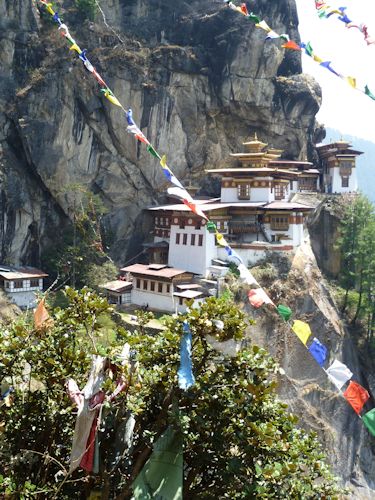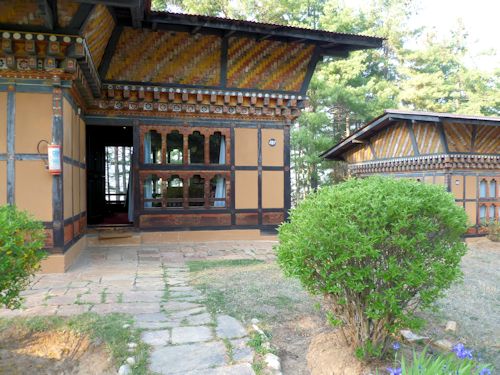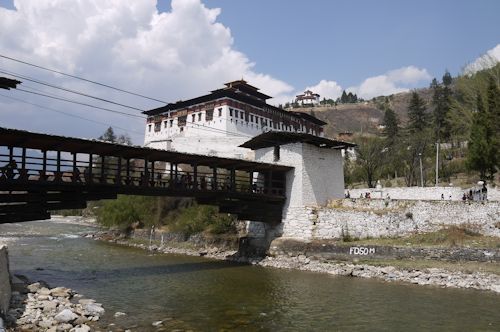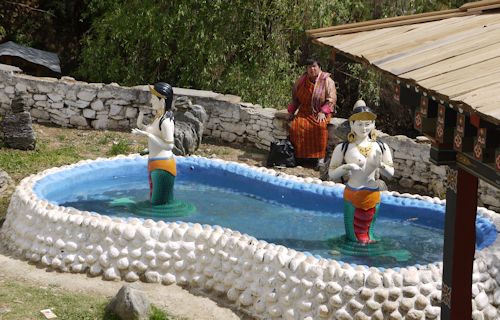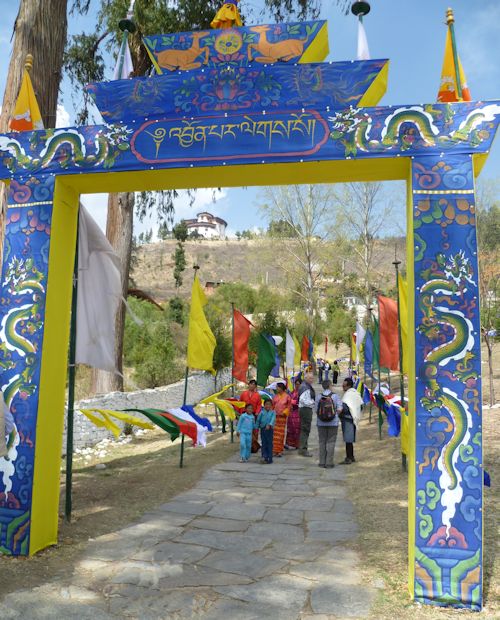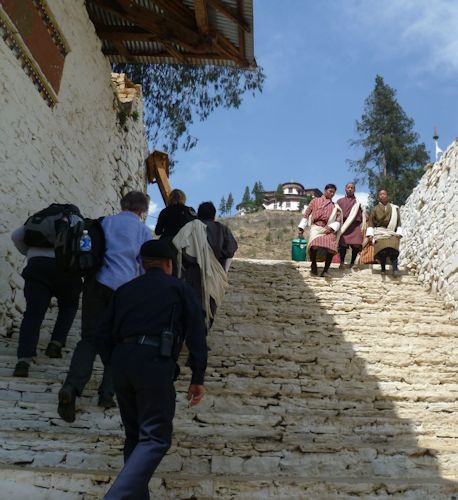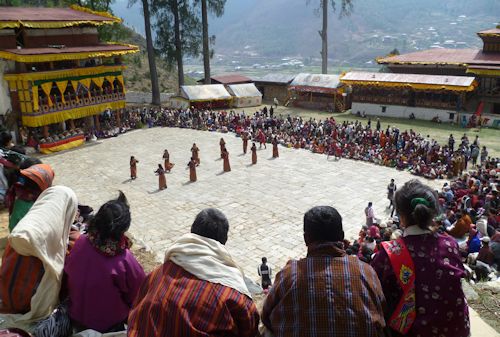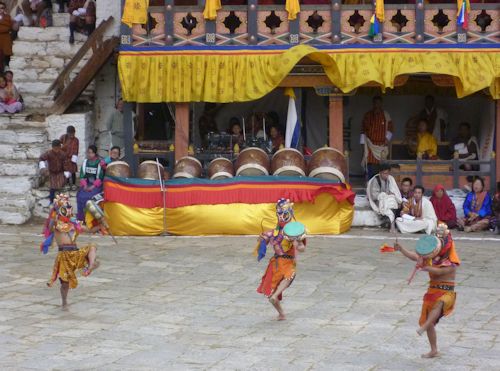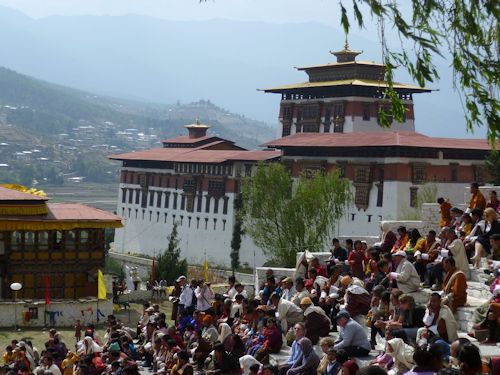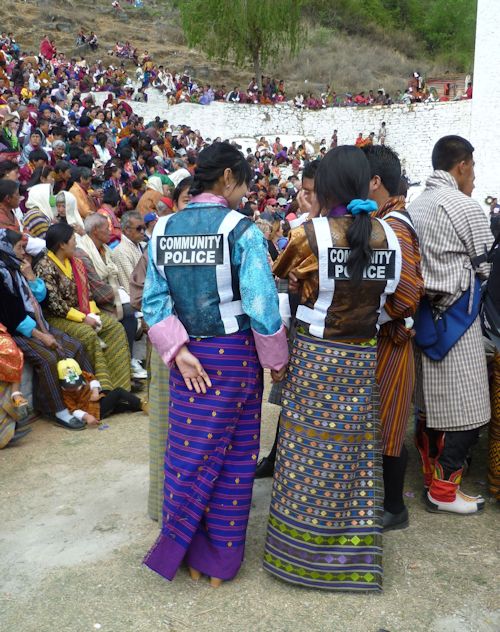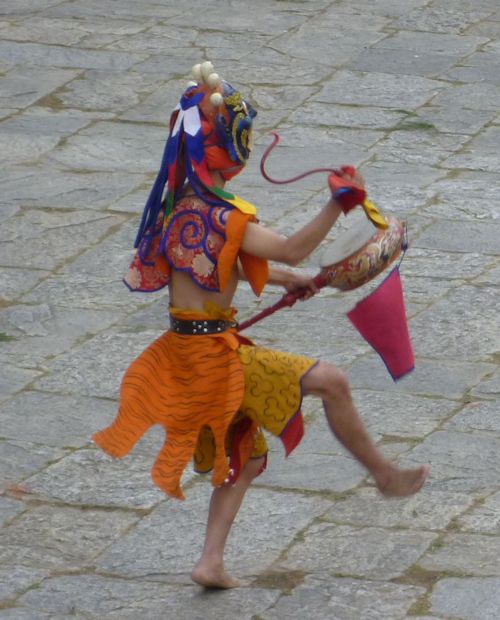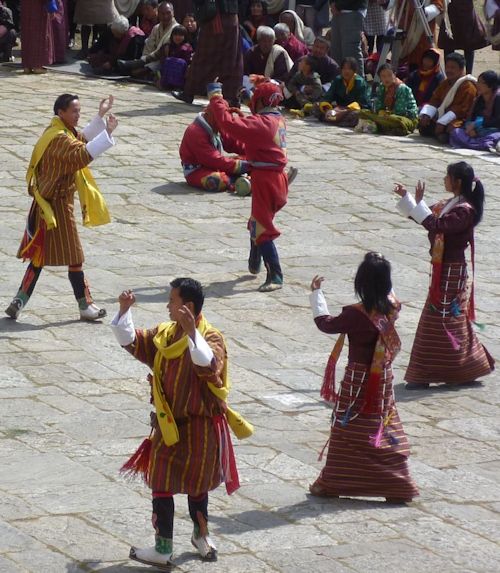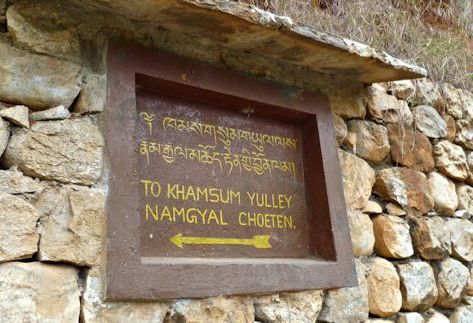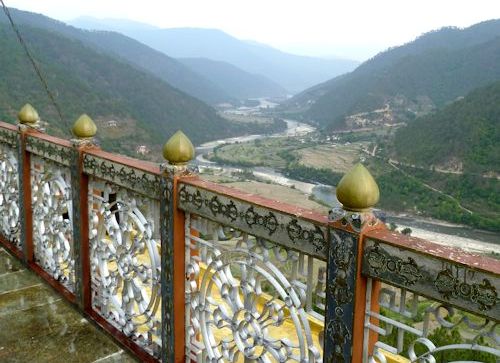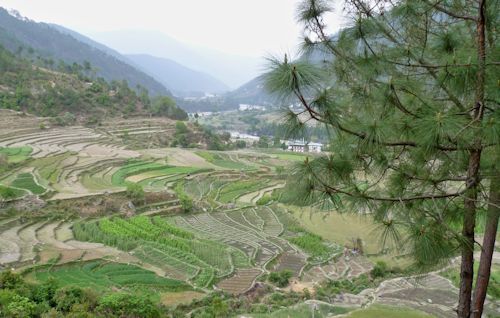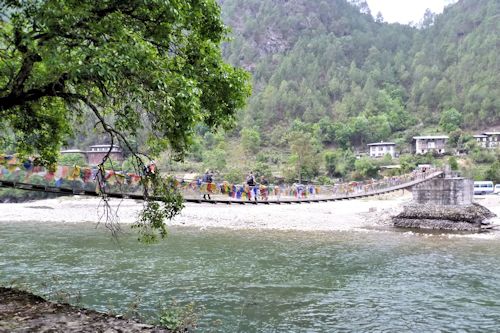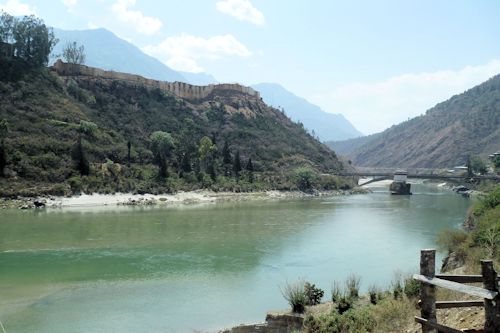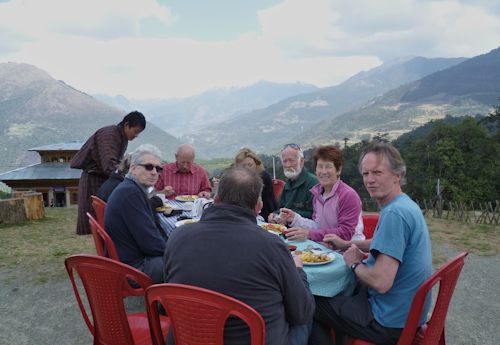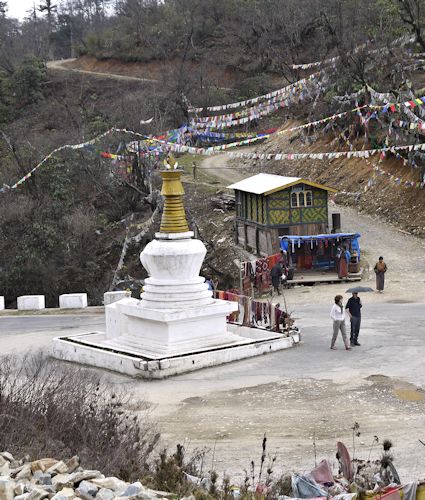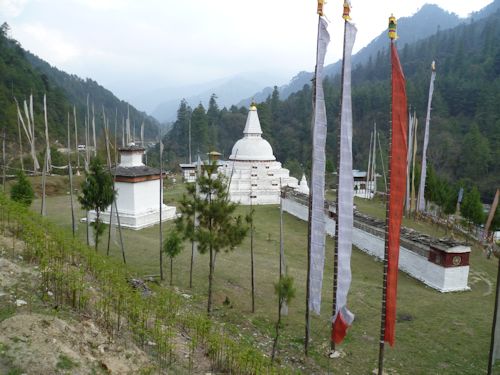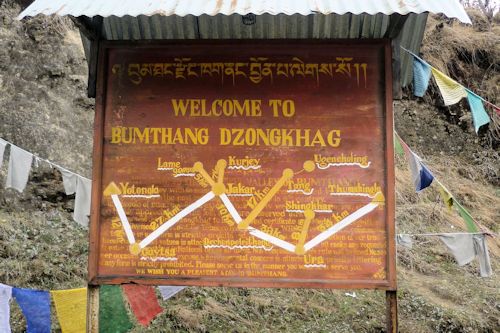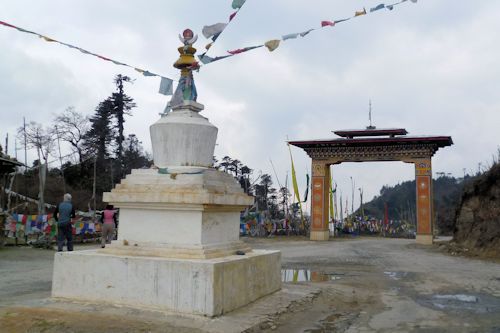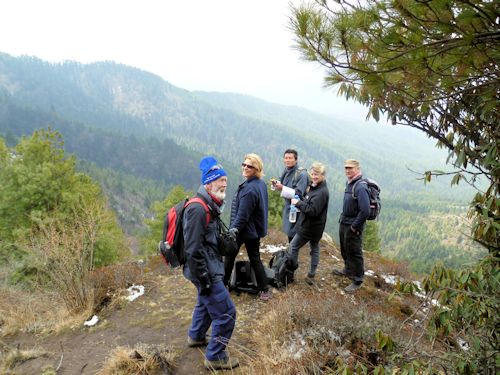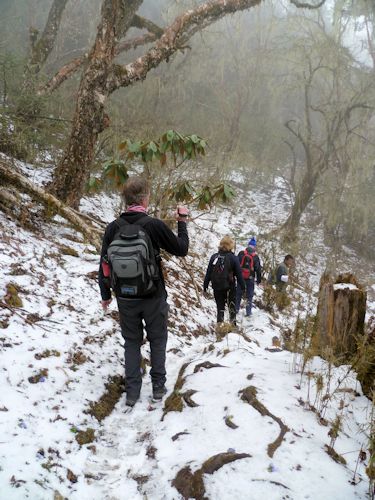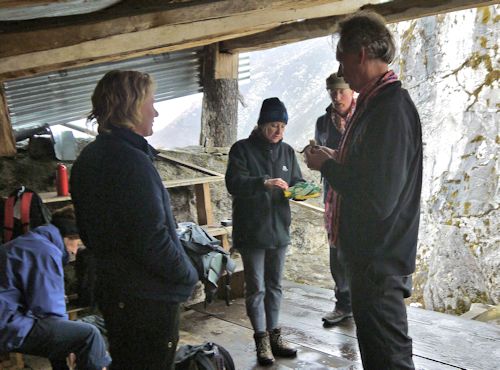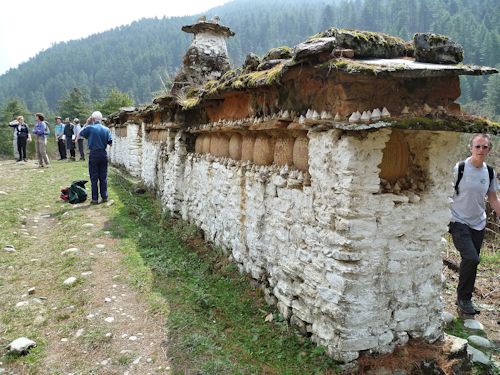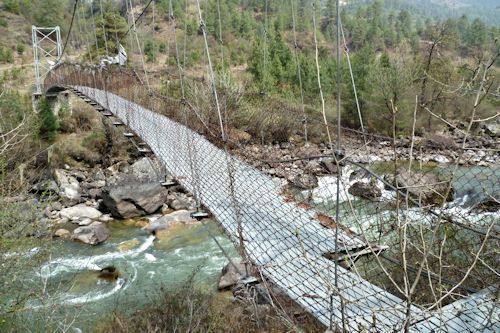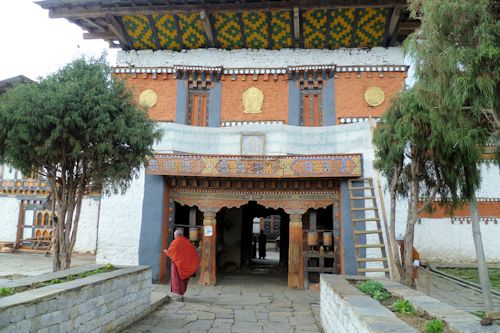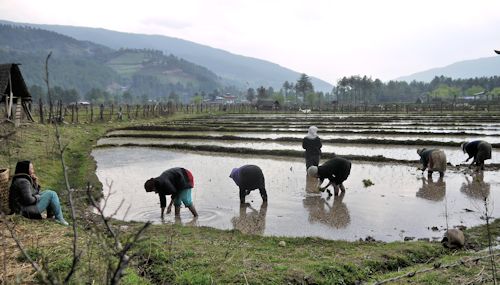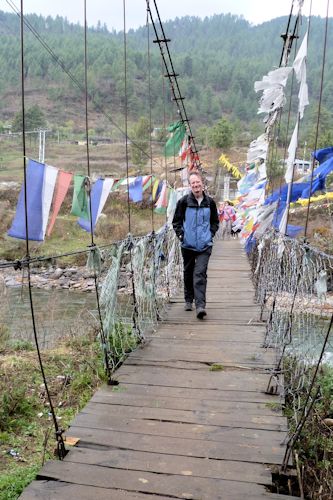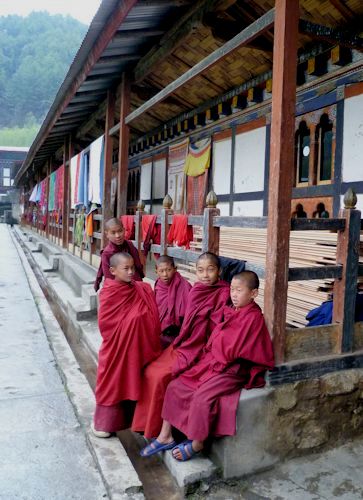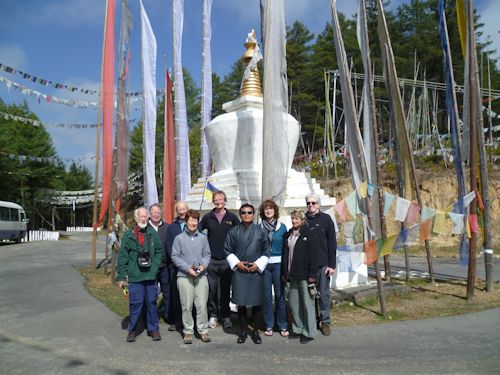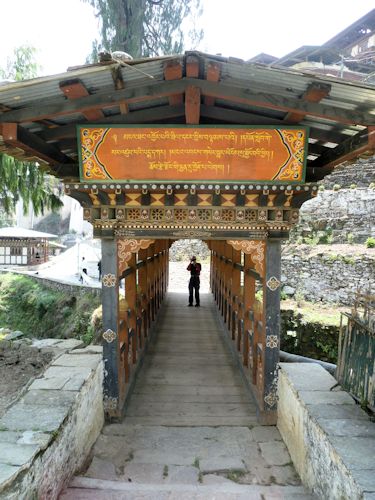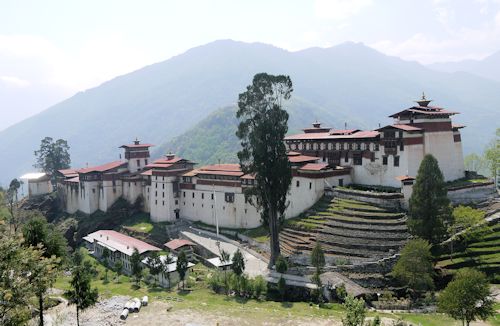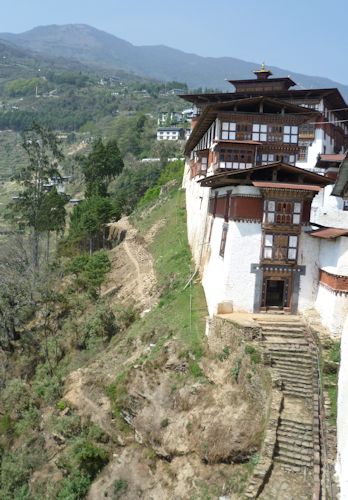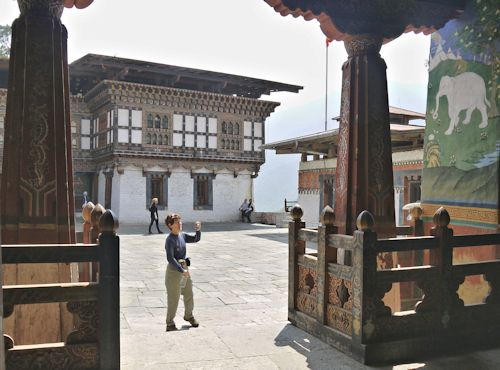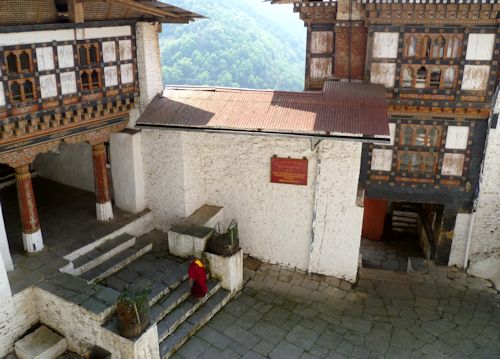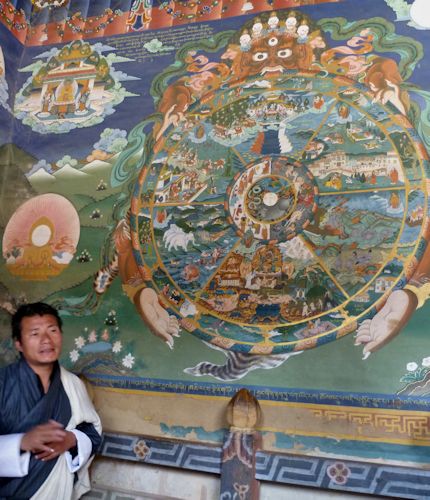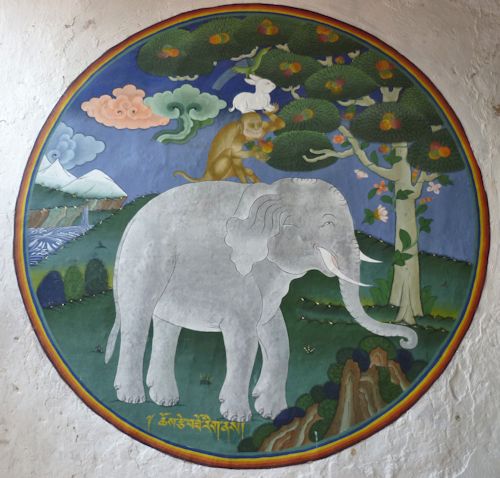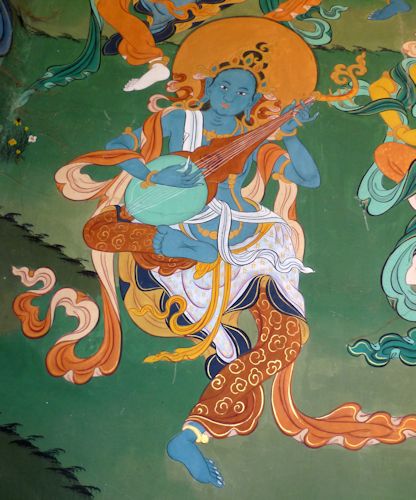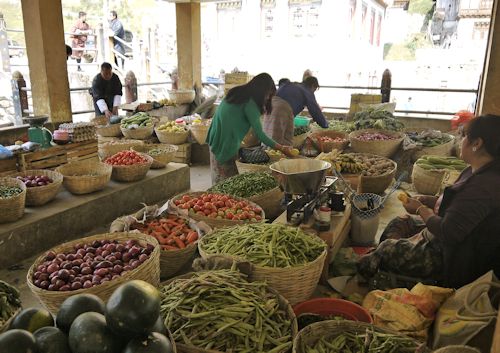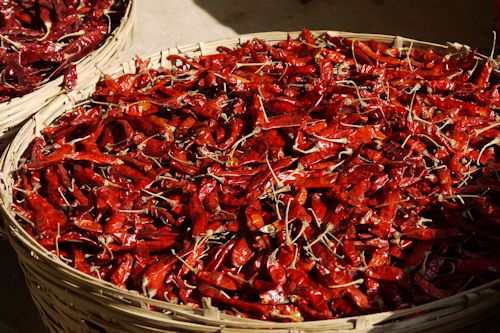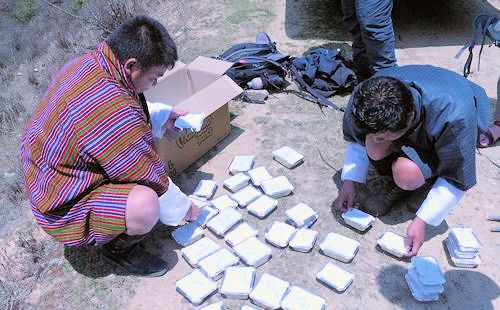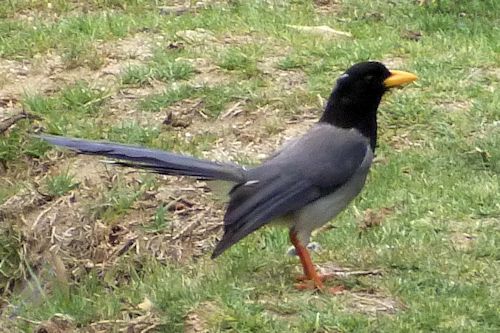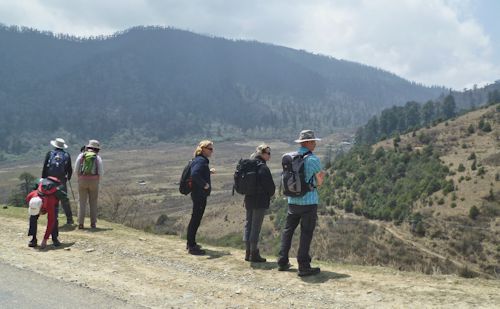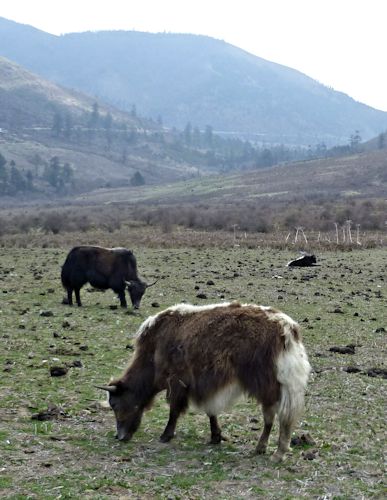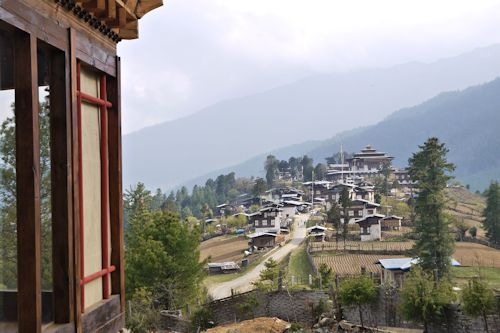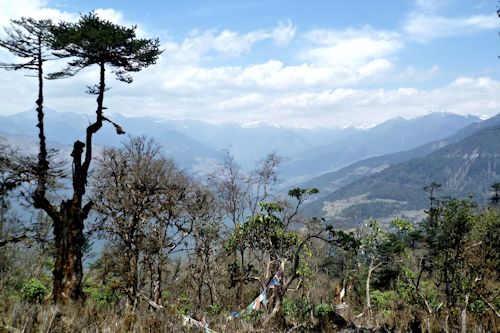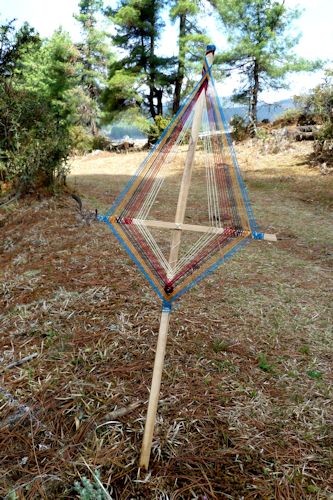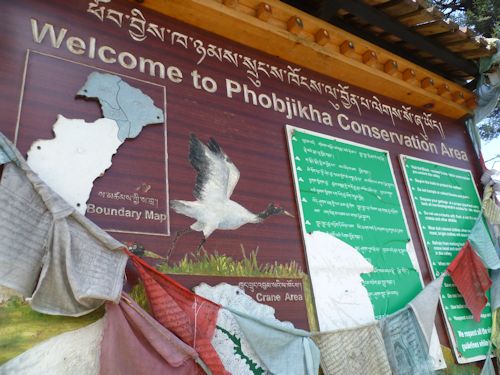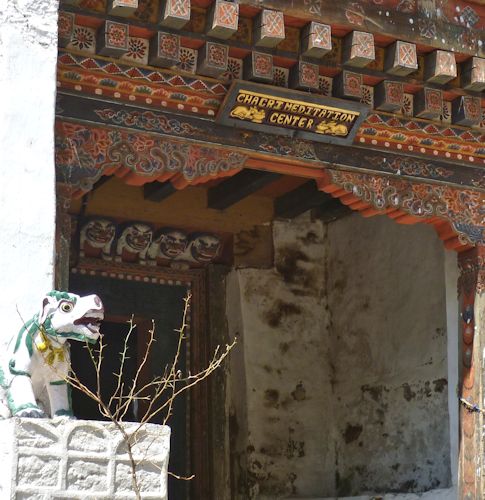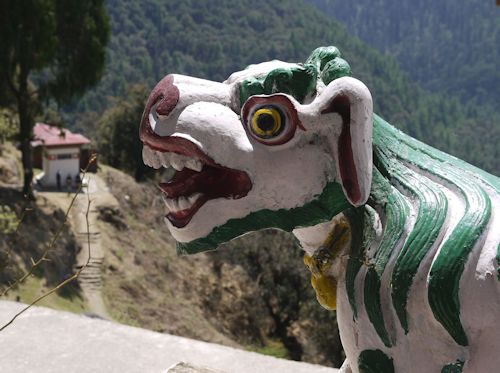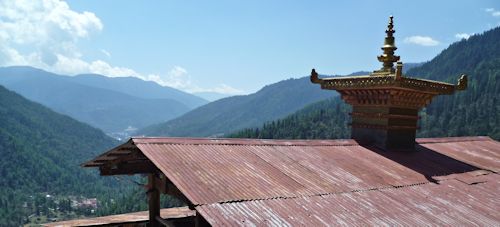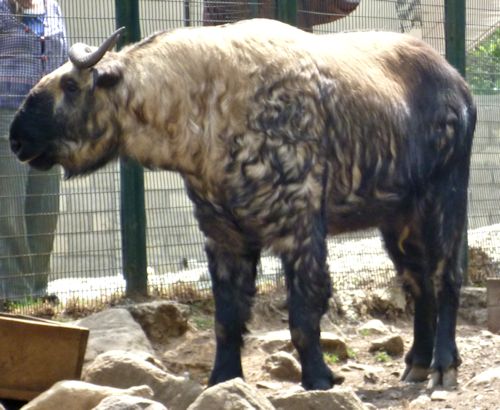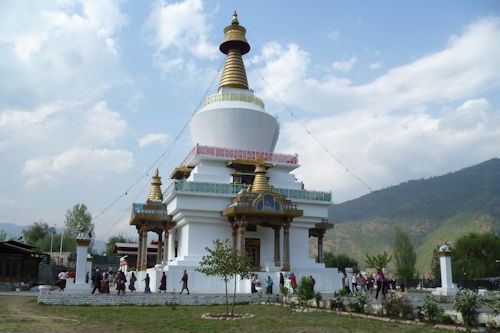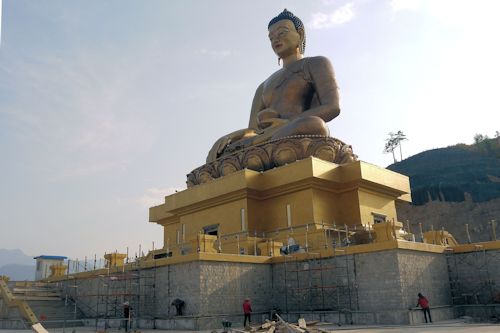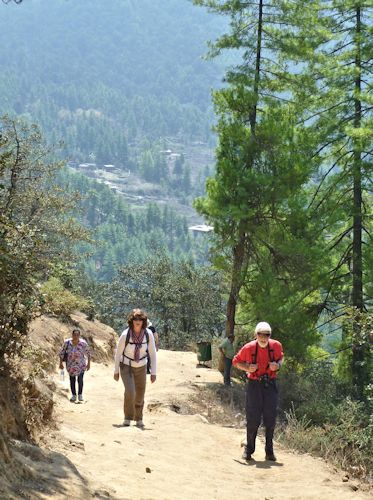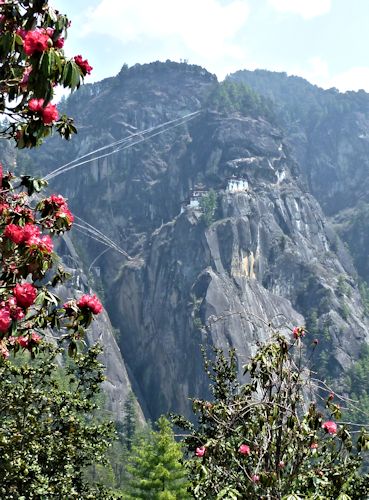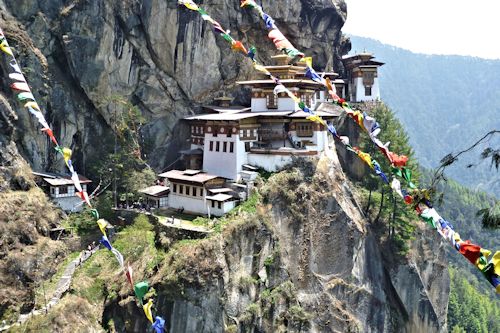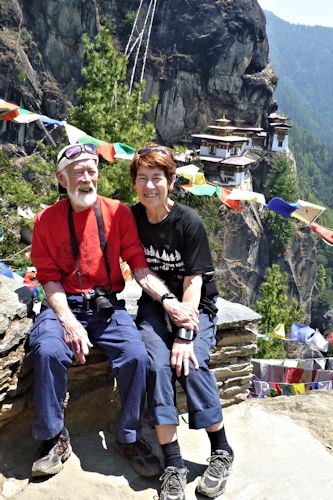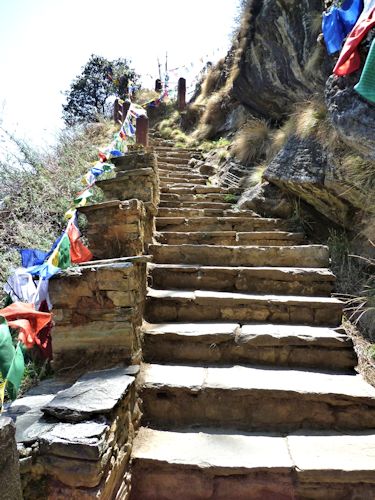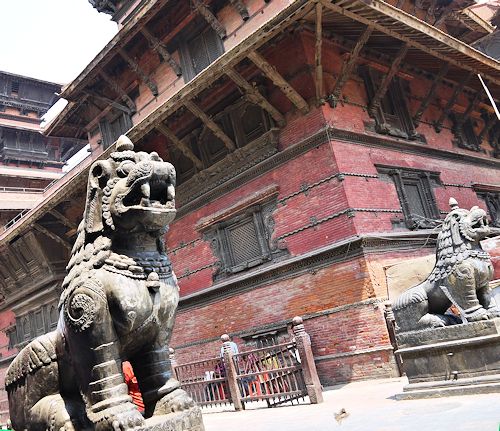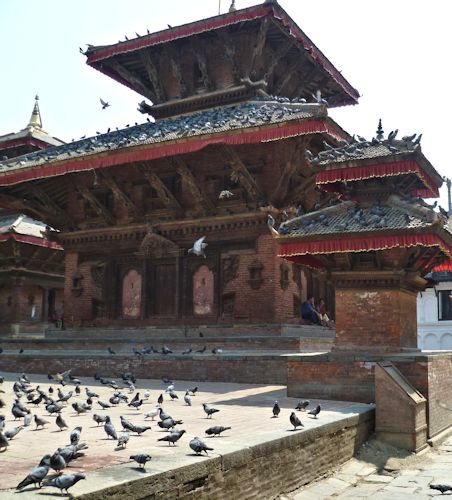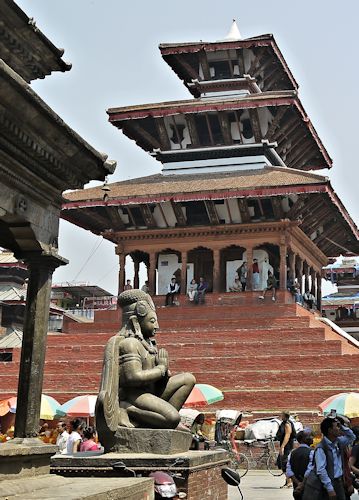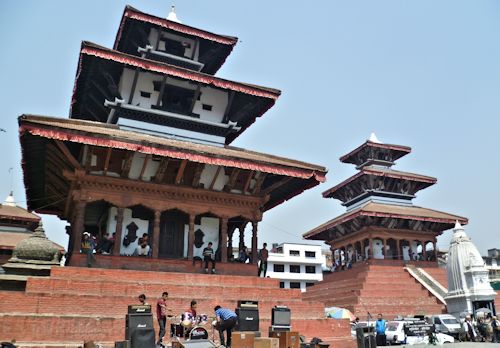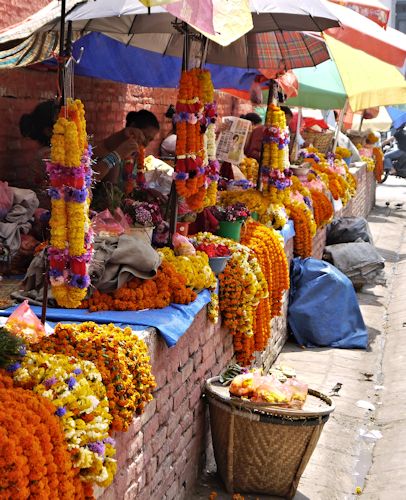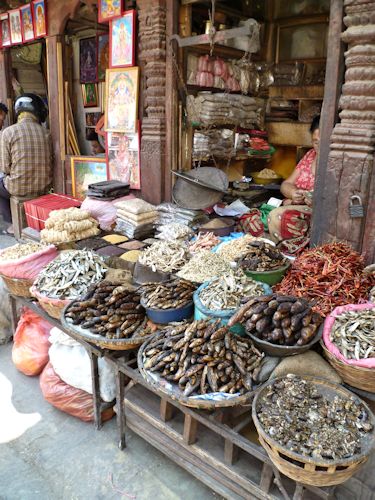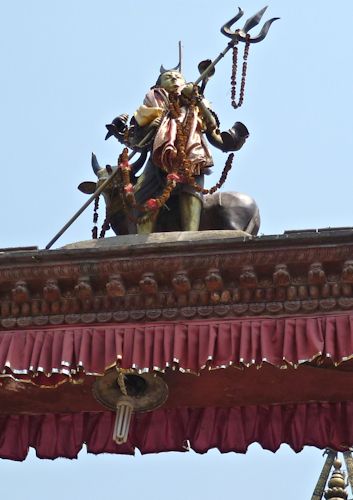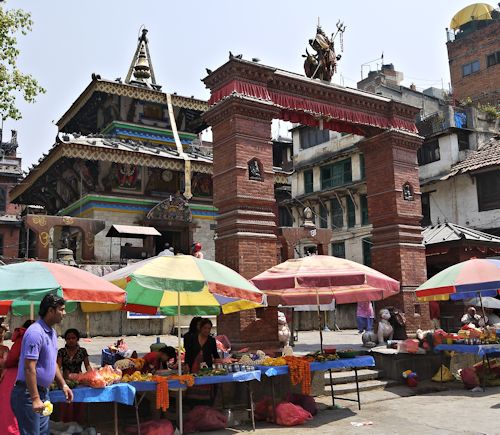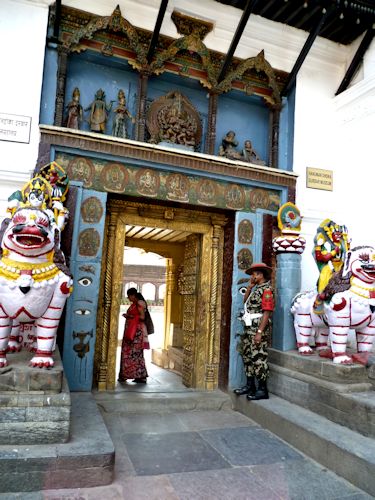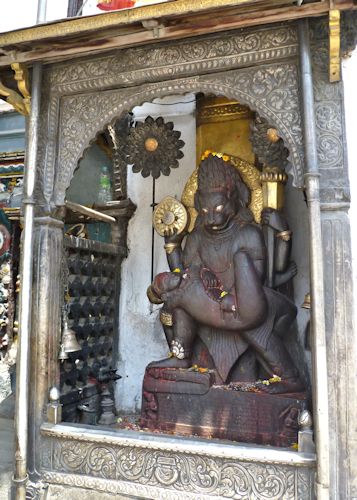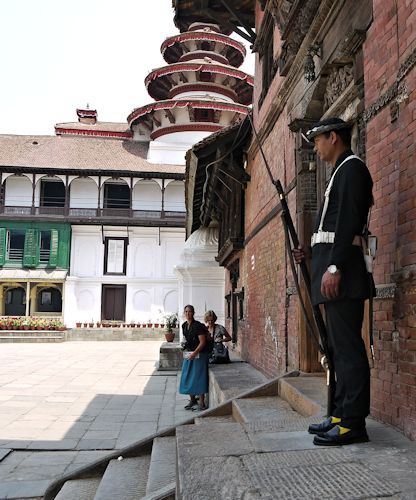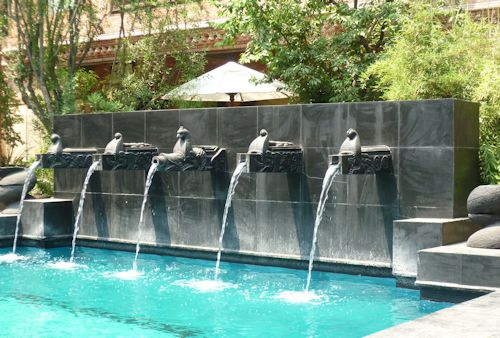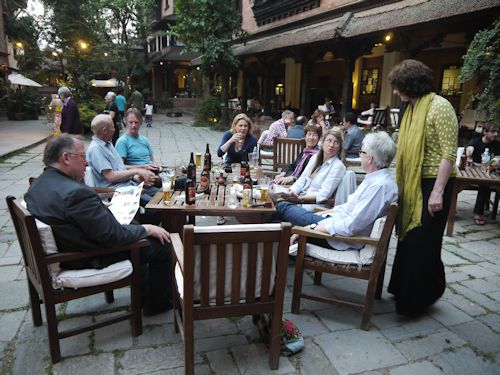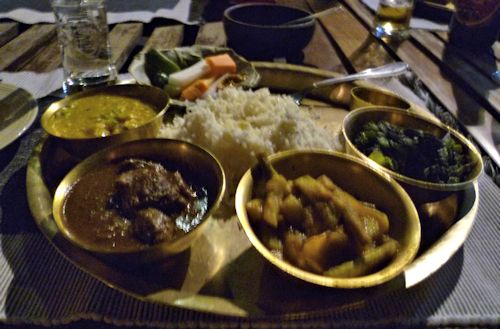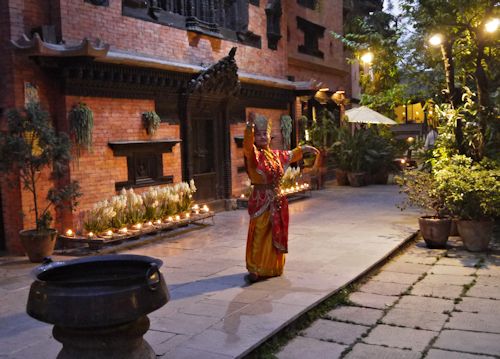Bhutan: April 2014
| | ||||||||||
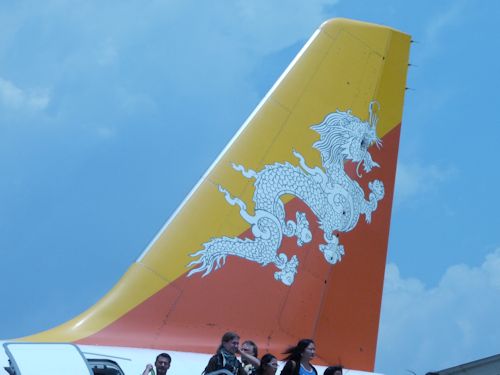
Homepage. Holidays menu. |
| |||||||||
| | |||
Day 1/2: Thursday 10 April/Friday 11 April
| |||
|
No direct flights to Bhutan, so we had to go in 3 stages, via India and Nepal.
An evening take-off for the overnight 9-hour flight Heathrow to Delhi; delayed take-off, then 'dinner' served after midnight, so only managed a half-hour snooze. In the morning, a 3-hour wait in transit before boarding our plane to Kathmandu. Too hazy to get good views of the mountains. For our overnight stay in Nepal, we had to fill in immigration forms, as well as queuing to have our visas stamped. A short drive to the Dwarika hotel in Kathmandu; quite posh, but in a very grotty area. Our room was enormous, with 4-poster bed and sunken bath, but too tired to appreciate it. We were also too tired for an expensive hotel dinner, but found nowhere else to eat nearby; so we just had coffee and a snack in our room, then bed at 7pm (= 2pm UK time!). Too much noise from a poolside barbecue outside our window meant we still needed ear-plugs for sleep. |
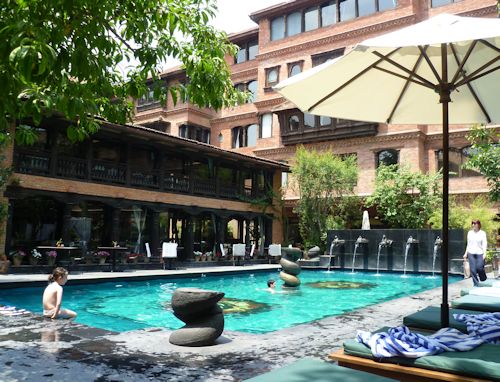
Dwarika pool |
||
| | ||||
Day 3: Saturday 12 AprilWeather: sun/haze am; strong wind, more cloud pm.
|
||||
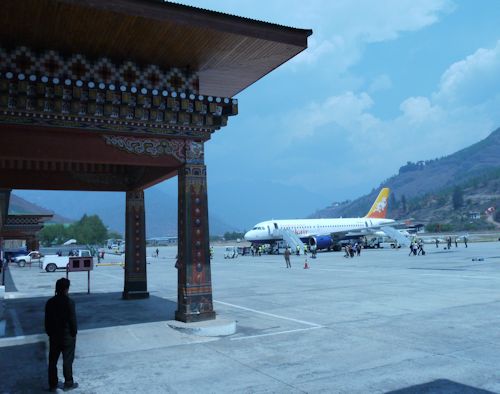
Paro airport - not exactly busy. |
Next morning, an alarm call at 5:30am for the bus back to the airport,
then we needed emigration forms before we were allowed to leave for Bhutan.
The small Drukair plane left on time (apparently unusual for Bhutan!); our window seat would have had good views of Everest if there had been less cloud - we just saw it's tip. Only half hour flight to Paro, then a scary, tight winding descent into the valley to the runway. We met with our guide and the other 7 members of the group for minibus ride to the Olathang hotel, on a very rough road (being upgraded by road-gang, but only with sledgehammers and shovels).
|
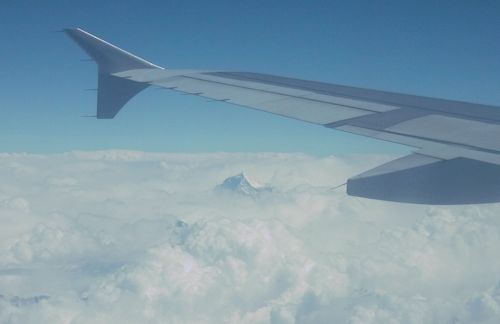
That's Mount Everest! (so we were told) | ||
After a very good buffet lunch at the hotel, the minibus took us to the 'Paro Teschu' festival at the Dzong.
| ||||||||||||||
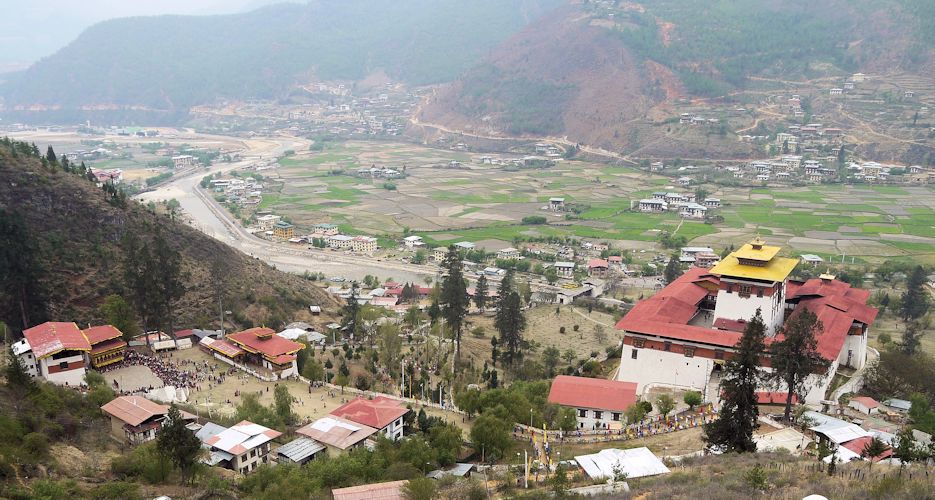
Paro Dzong, with Teschu courtyard on the left. |
||||||||||||||
|
We walked across the footbridge, past a small garden (with naked mermaids?!?),
then up some very steep steps - hard work at the unaccustomed altitude. Following the crowds, we reached the courtyard to watch the stately traditional dancing, and symbolic masked performances.
|
||||||||||||||
| The 'stag and hounds' fable was enacted to a commentary,
by performers who moved among the audience (similar to a mummers play). 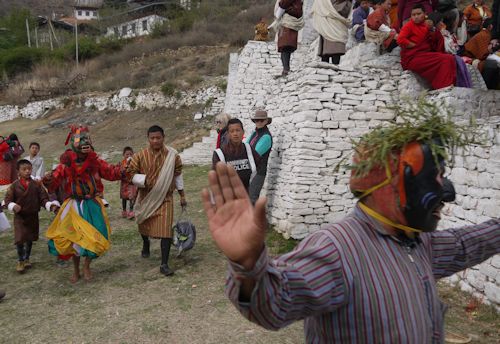
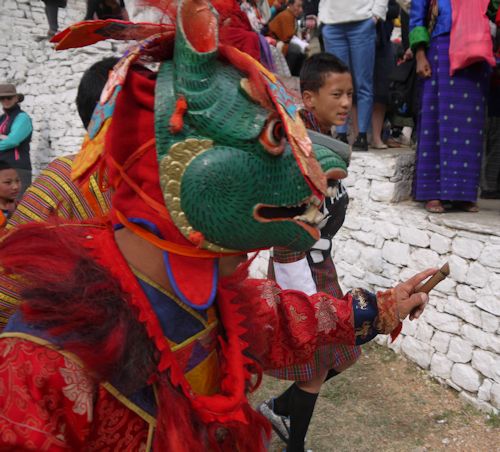 |
||||||||||||||
|
Back in the bus to the hotel for 4pm tea-and-biscuits, then time to recover before we all met up at 6pm in the bar, for a meeting with the local tour boss, apologising for having to change our itinerary at Gangtey due to the hotel being overbooked. After another buffet dinner, it was straight to bed to catch up on missed sleep. |
||||||||||||||
| Return to top | ||||||||||||||
| | ||||||||||||||
| ||||
|
Up at 7am, to leave hotel at 8:30, so we could be early enough to find seats at todays visit to the Teschu. 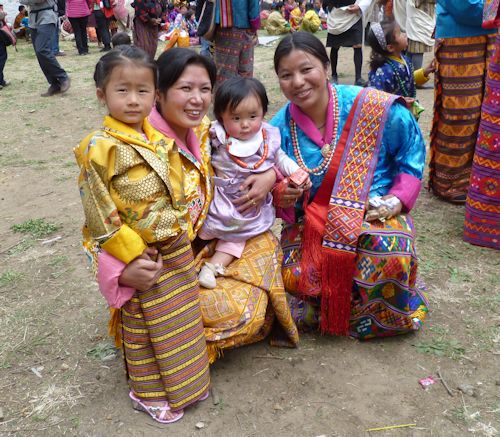
Everyone came in their Sunday-best. |
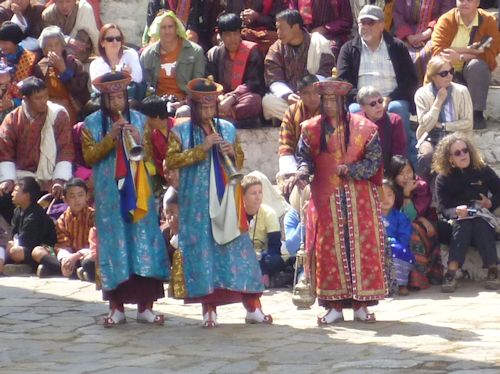
Live music to accompany the masked dances |
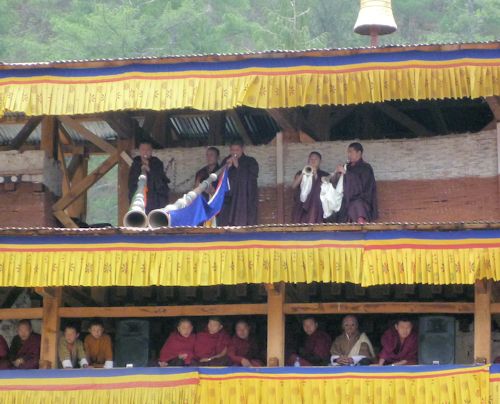
Horns - loud but not very tuneful |
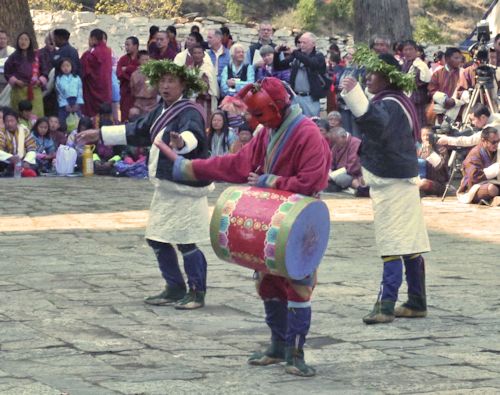
The red jesters up to their tricks again. |
Mask of the wrathful gods
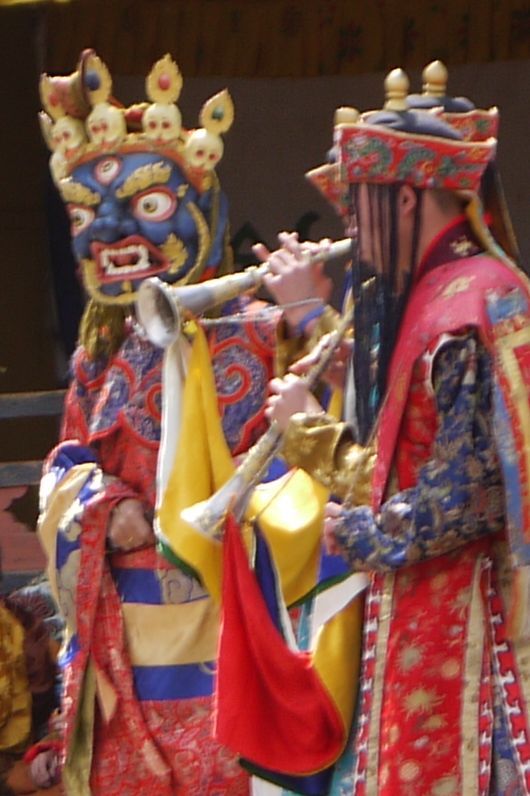 |
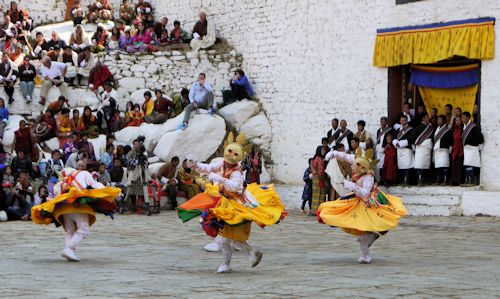 |
unmasked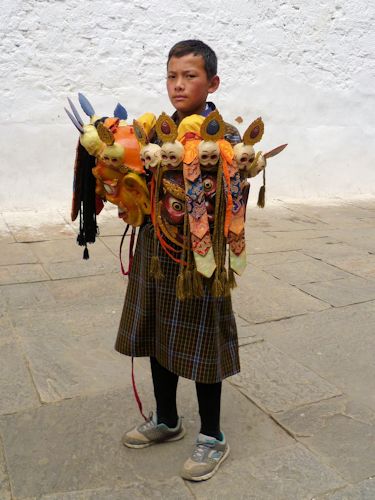
|
|||
After lunch at a restaurant in Paro (similar buffet yet again), we returned to look around inside the Dzong then drove on up to the museum at the Ta Dzong (watchtower), but no cameras allowed inside. We quickly learned that at a Buddhist site, one is expected to always move in a clockwise direction, to bring good fortune. |
|||||
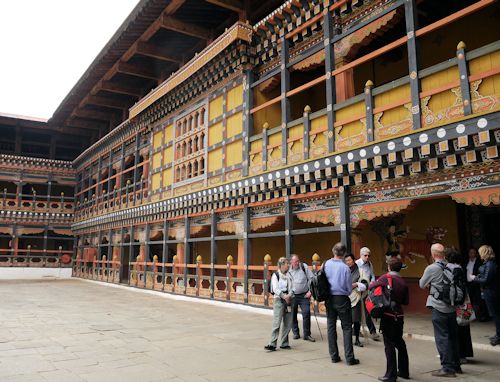
Entry to the Dzong: Guide Tschering explains.... |
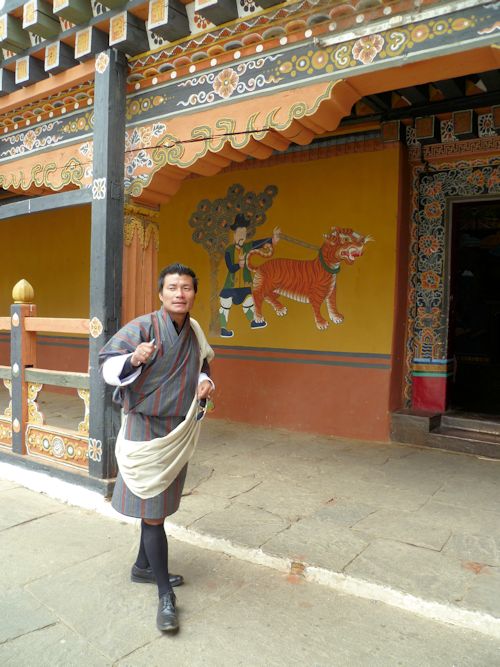
the tiger |
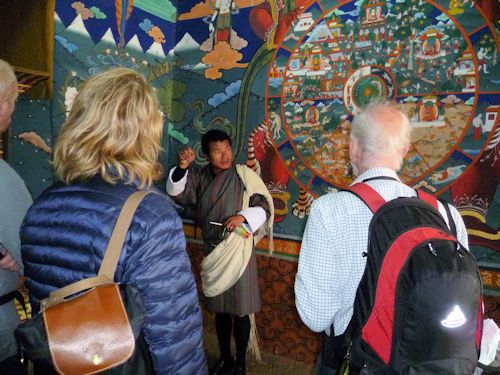
the 'Wheel of life' |
|||
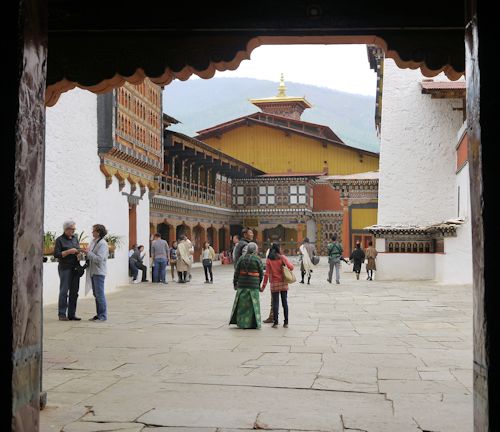
Inside the Dzong courtyard |
Then a short drive up the Paro valley to the Kyichu Lakhang (7th century temple) for more explanations of the Buddhist symbolism. We returned to the hotel in Paro, for the customary 4pm tea-and biscuits, then dinner and another early night. |
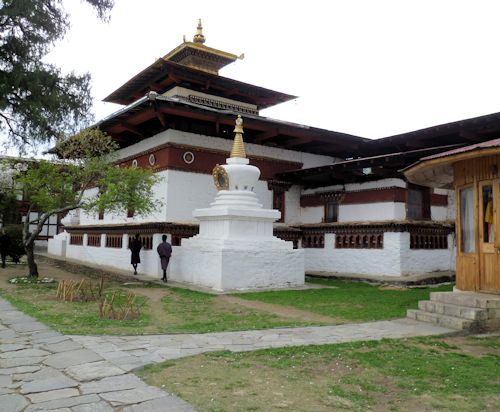
| |||
| Return to top | |||||
| | |||||
| |||
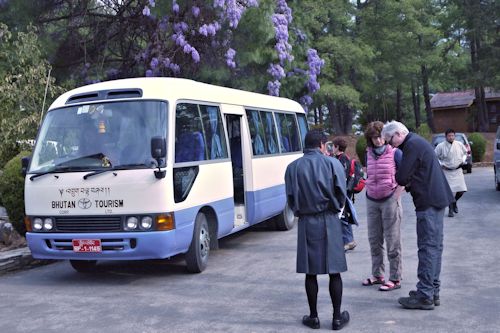
Up at 7am, for 8am start on road to Punaka via the Dochu La pass. |
'National Highway no.1' was a very narrow windy road, with major roadworks all along. We had to wait in a long traffic queue while it was closed for blasting, along with lots of these brightly decorated lorries which were used for most goods transport. | 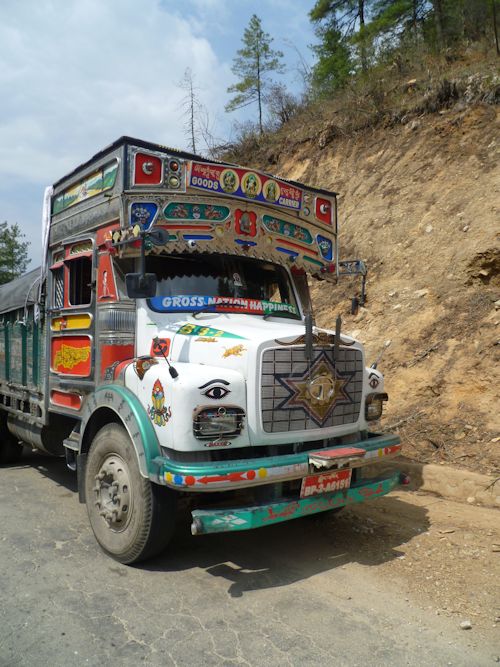 |
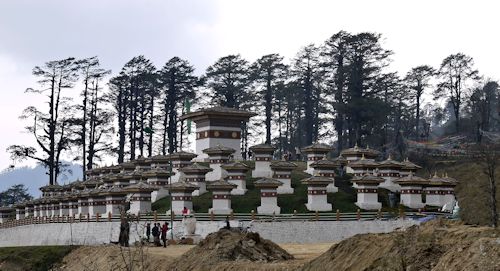 There was a brief 'comfort stop' at the Dochu La pass, and a view of the 108 chortens (though we didn't count them) |
|
Arrived at Kuruthang (new suburb of Punaka) and stopped for lunch, then continued up river for our first walk. | |||
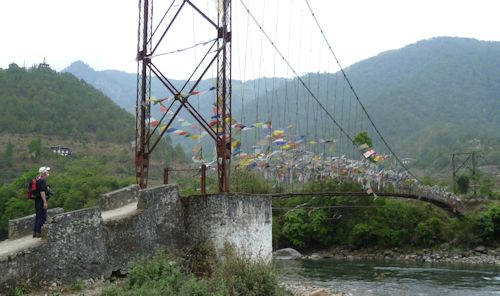
Across the river on this wobbly suspension bridge 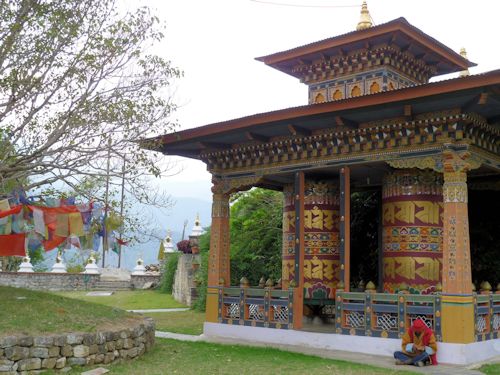
giant-sized prayer-wheels at the chorten |
|
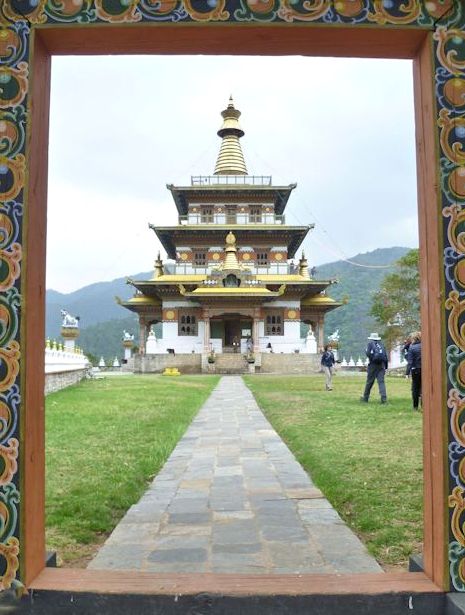
Khamsum Yulley Namgyal Chorten |
||||||||
| Return to top | ||||||||||
| | ||||||||||
| ||||||
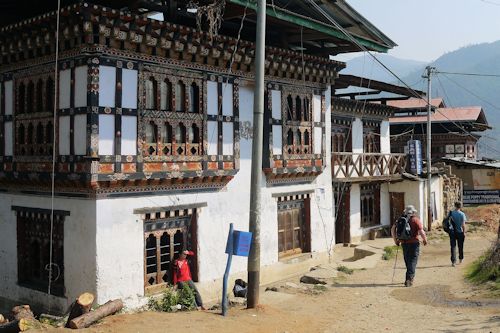 |
First stop was for a short walk across the fields to Chime Lakhang. The area is dedicated to Drupka Kunley (the 'Divine Madman') and the numerous phallic symbols are a tribute to his sexual reputation. | 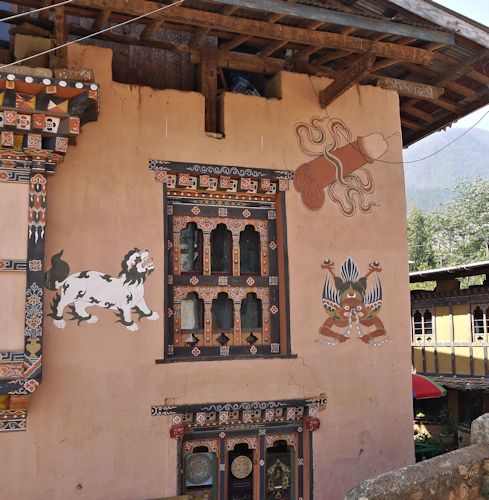
|
||||
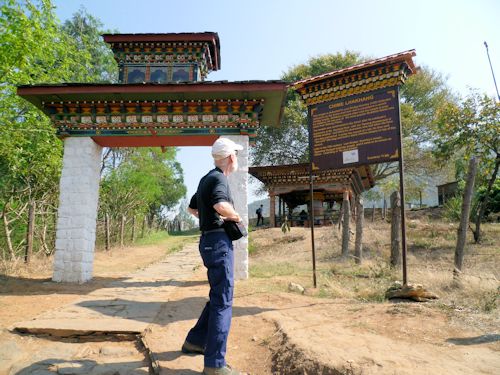 |
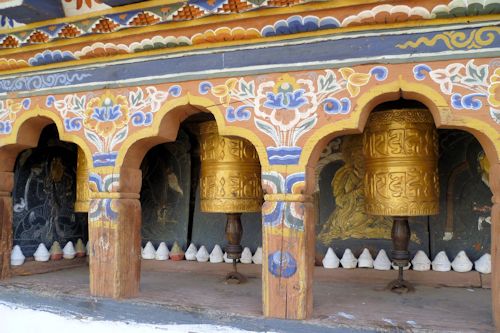 |
This song-thrush posed obligingly, they are common all around here. 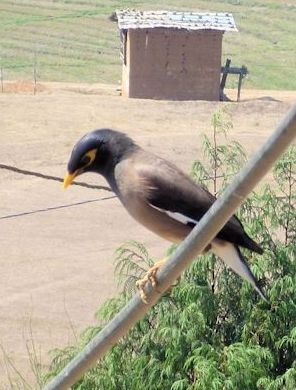 | ||||
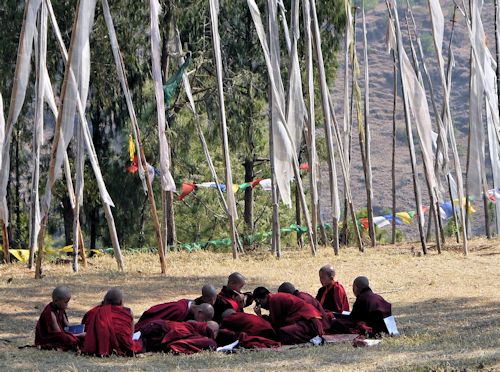 trainee monks at lessons |
Bhutanese people come here for fertility blessings, and inside the temple, we too were treated by the monk to the traditional tap on the head with his wooden phallic symbol! |
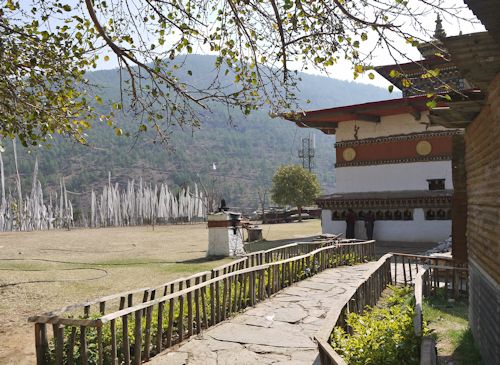 Chime Lakhang |
||||
More short photo-stops en-route to Trongsa:
| ||||||
Trongsa Dzong and Ta-Dzong watchtower above it on the hill.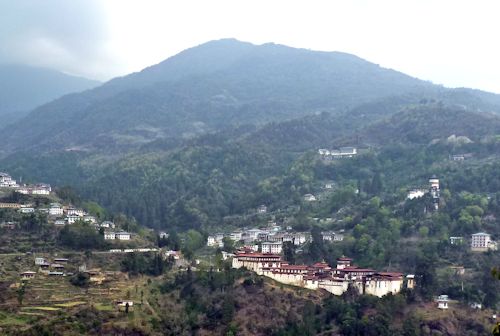
|
We saw Trongsa, and its Dzong, from across the valley, but still a long winding road to reach it.
Then another 4k up the hill to our hotel - high on the hillside above town in the picture.
Small and friendly, Puensli was our favourite hotel of the stay, despite the power cut when we arrived (had to shower by candle-light) |
Puenzli guest house.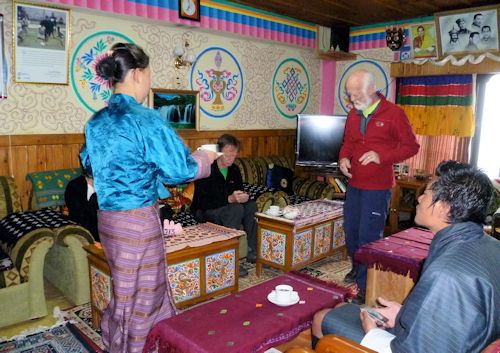
|
||||
| Return to top | ||||||
| | ||||||
|
We turned off the rough 'main' road, onto a very rough unsurfaced track for about 5 miles, to Tharpaling temple for the start of our walk. Surprised the minibus could make it over the potholes, and up the steep turns. Before we started to walk, our driver Tseten produced a basketful of colourful woven silk scarves - handmade by his mother (so he said). We succumbed to his sales pitch - bought 2. |
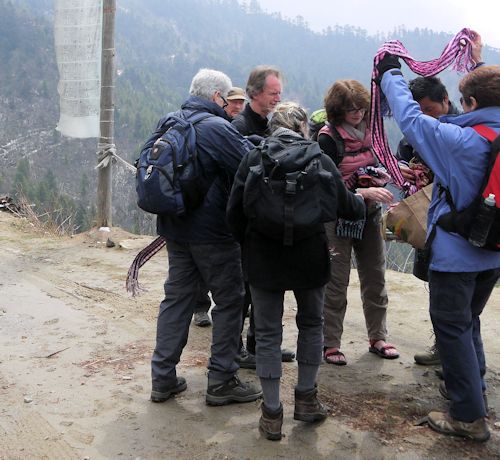
| |||
Today's walk was more 'challenging' than 'gentle'. Steep uphill, above the snow-line for the first half, up to the Shutre Sae pass (3800m). Here we were surprised to find a glass-encased statue, but glad to get out of the weather in the rough wooden shelter behind it. We shared cake (all the way from Brighton!) while waiting to re-group. We had to imagine the mountain views - too much cloud in the way. |
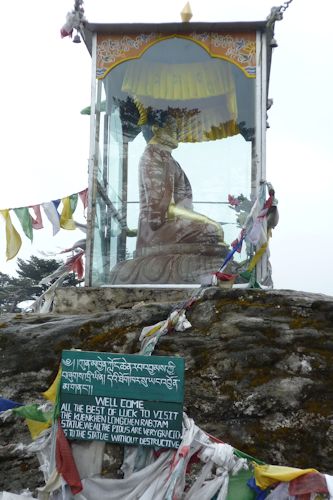
| ||||
|
|||||
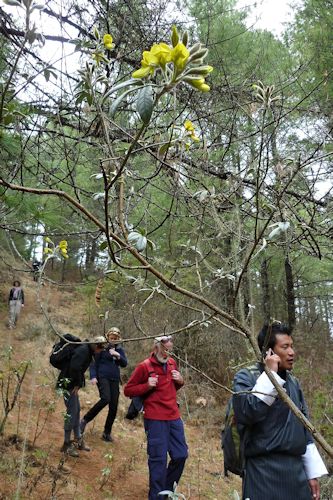
|
Lots of primroses in the snow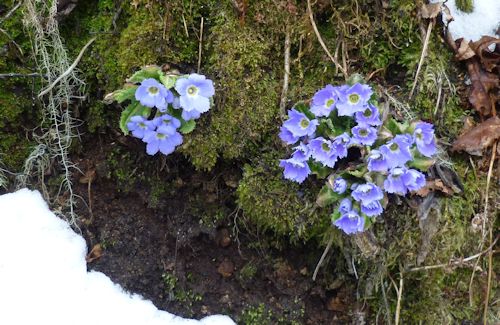
The walk down was much easier, though still steep, with carpets of primulas. We were a couple of weeks too early to see the rhododendrons in flower. 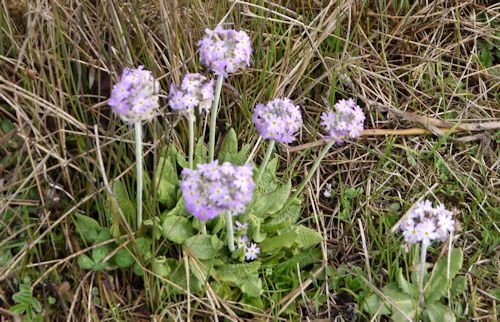
|
After a picnic lunch on the way down, we returned to the bus,
which took us into Jakar to look in the Dzong. 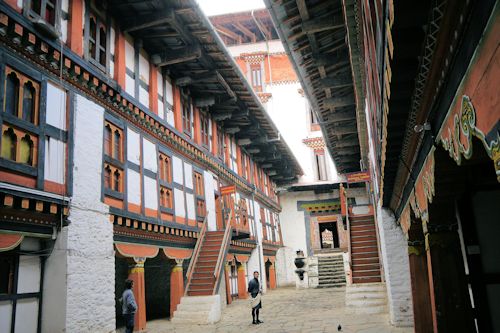
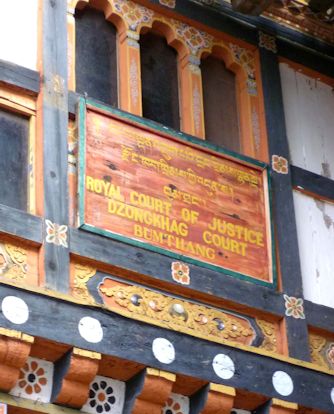
As in many dzongs, it also housed local administrative offices. |
|||
| Our hotel in Jakar was a large ugly modern building (could have been anywhere).
No hot water in our room - their 'maintenance man' looked about 15, and didn't have much clue, but promised to fix it.
Another early night after dinner at the hotel. |
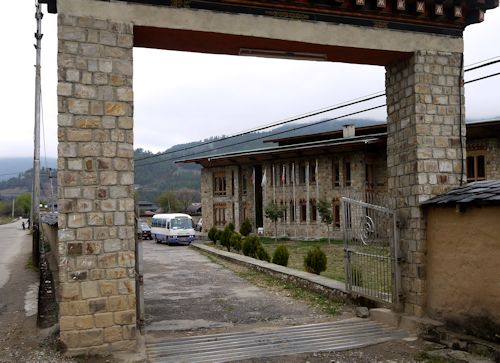
|
||||
| Return to top | |||||
| | |||||
| ||||||
We drove along another rough track, up the Chokor valley to Tangbi.
Our walk started at the gompa here, past a long 'mani' wall (for chanting your mantra)
then crossing the river on a decrepit suspension bridge.
|
We walked about 6 miles up the valley, through alpine flowers in woods and meadows.
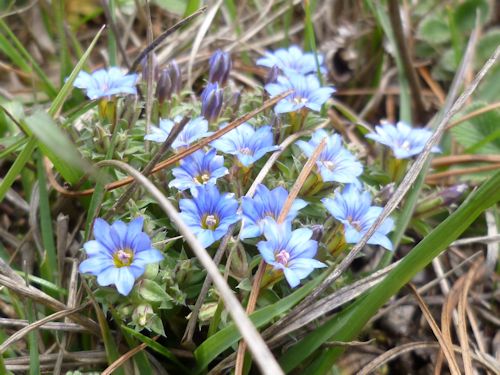 |
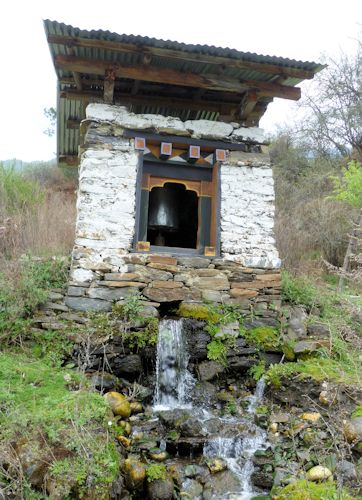
water-powered prayer-wheel; does it still bring good fortune if you don't turn it yourself? |
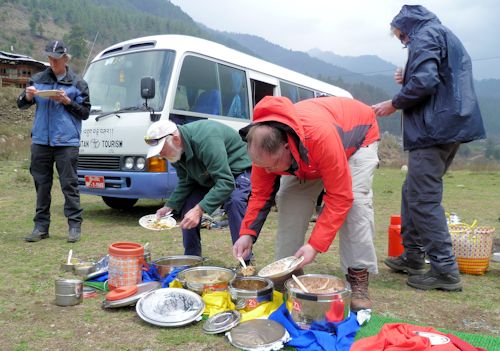 The minibus was waiting at Ngang Lakhang, at the end of the walk, with our posh hot-buffet picnic lunch laid out on the grass. Unfortunately the showers were on the way, and we got a little damp. |
|||
| | ||||||
Back on the bus, down the valley towards Jakar,
to Jambey Lakhang, for the start of another short walk on a farm track, up the river,
to the large group of 3 temples at Kurjey.
|
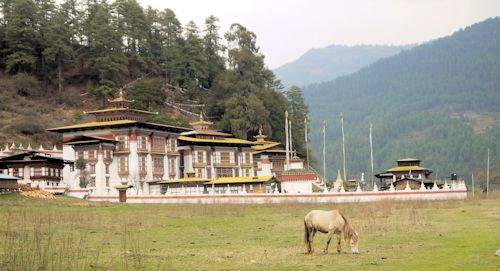
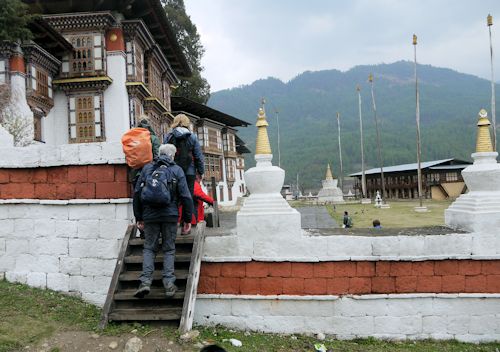
Kurjey Lakhang: 3 temples, built at different times, plus a chorten. 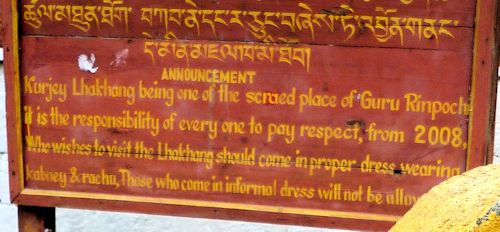
It's expected that you wear formal dress when visiting any temple, but they don't usually announce it like this. | |||||
|
||||||
| We stopped on the way back at the 'Wine shop' in the hope of finding some cider-type drinks (as there were lots of apple orchards around). But all they had was fiery apple brandy - only got a miniature as didn't dare try the large bottle. |
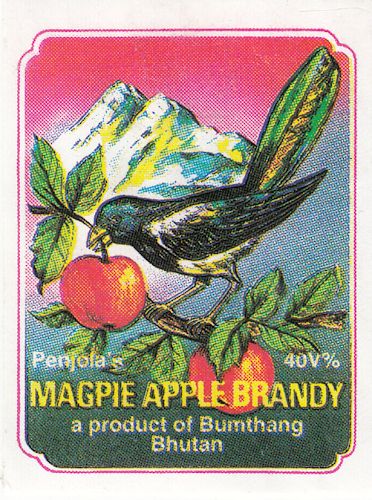 |
Then back to the same hotel - plenty of hot water in our new room,
but a power cut meant another torch-lit shower.
However, the wood-burning stove in the room made it toasty-warm. | ||||
| Return to top | ||||||
| | ||||||
|
Next stop at the handicraft center; intricate hand-woven products for sale.
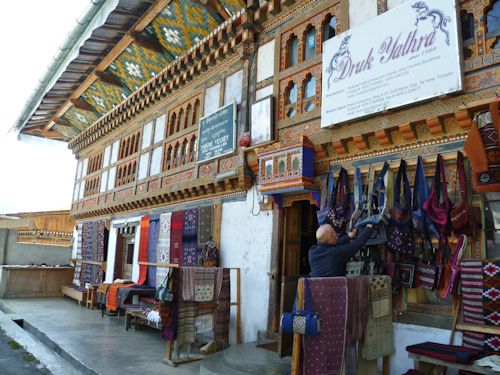
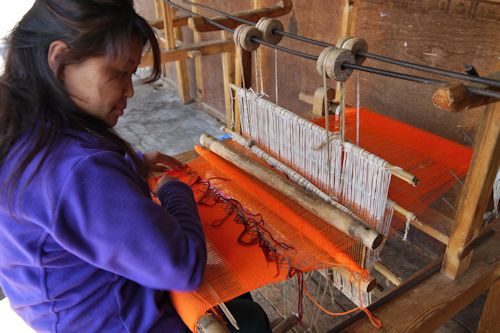
| ||||||||||
On arrival at Trongsa, we went straight to the Ta-Dzong, for lunch in the cafe there.
Afterwards, we went inside to climb up the 10 levels of museum exhibits (great view from the top, but no cameras allowed).
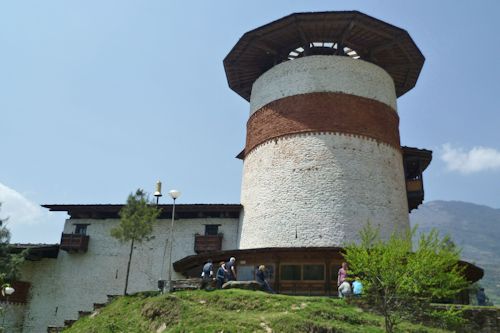
|
Then we drove down to the magnificent Dzong itself, walking across the bridge to the entrance.
|
||||||||||
|
|||||||||||
| Return to top | |||||||||||
| | |||||||||||
| ||||||||
We had to pass through a 'customs' checkpoint, to show our route permit on the border between central and western Bhutan districts.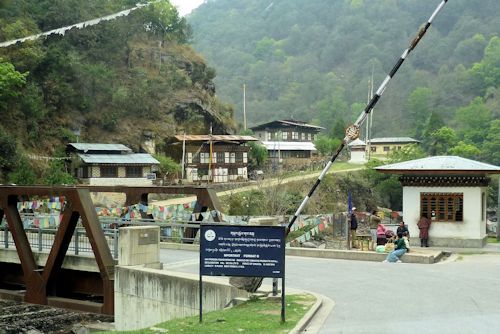
First photo stop at the roadside monkeys - attracted by the over-ripe bananas supplied by our driver. 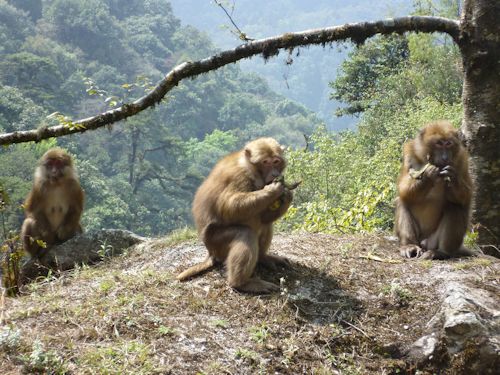 |
Another 2.5 hours to the start of our walk - just before Pele La pass.
|
|||||||
| Return to top | ||||||||
| | ||||||||
| |||||||||||
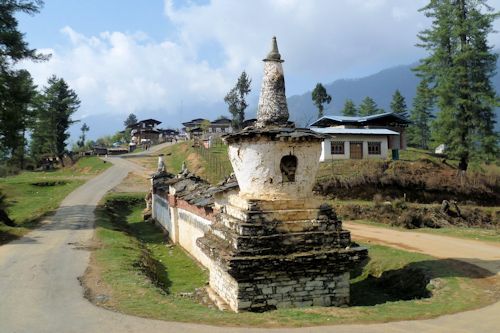 |
No bus this morning, as we started with the short walk from the hotel to Gangtey Gompa, past another long mani-wall.
Then a happy group of labourers (all ladies), singing as they tramped clay on a new roof | 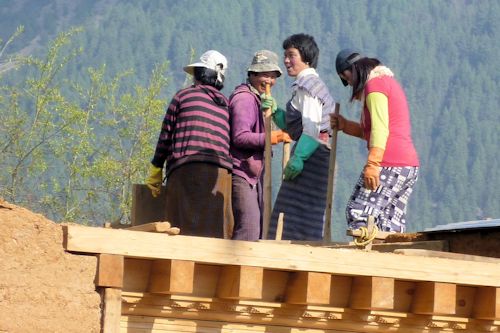 |
|||||||||
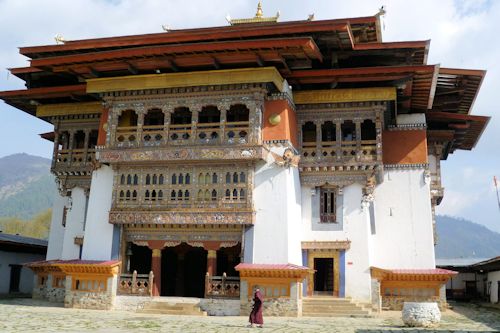 . |
The gompa was very colourful and ornate, with masks and gargoyles around the outside | ||||||||||
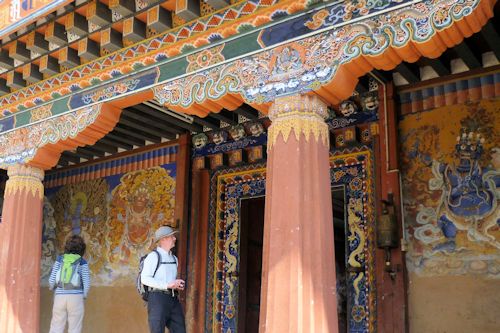 |
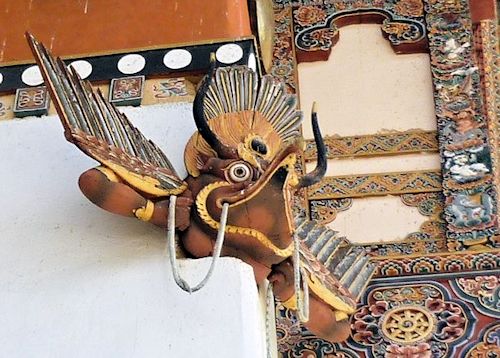 |
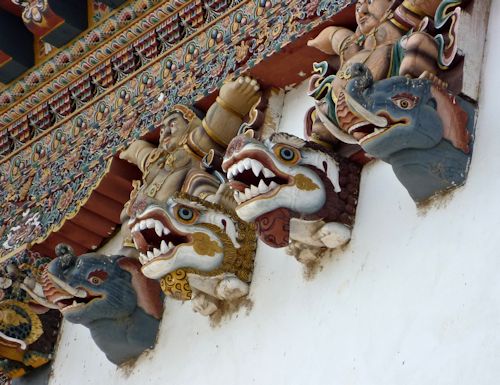 |
|||||||||
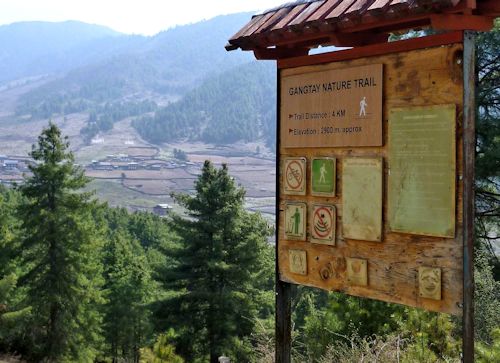 |
|
||||||||||
| | |||||||||||
| On to the bus again for the drive back to Punaka, with a lunch stop at the same restaurant in Nobding (but the tables were set up inside this time - just drinks on the terrace). At Punaka we went straight to the dzong (the largest yet). | |||||||||||
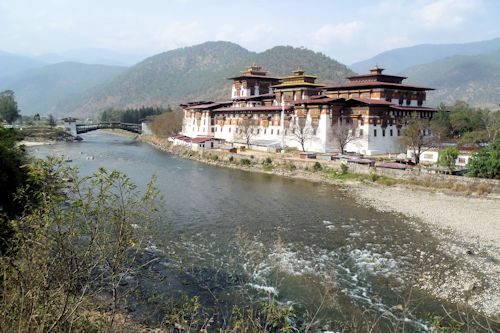 |
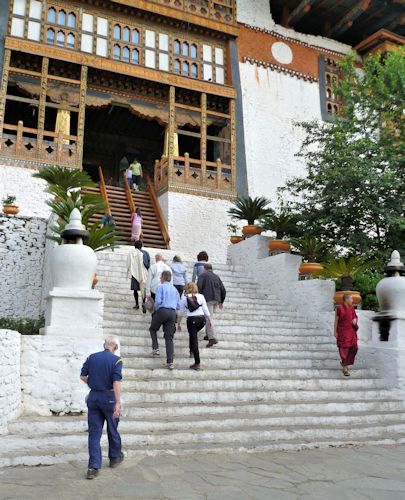 |
Extremely steep steps up to the entrance.
A guard stops anyone entering the most sacred inner temple, where the coronation ceremony takes place. |
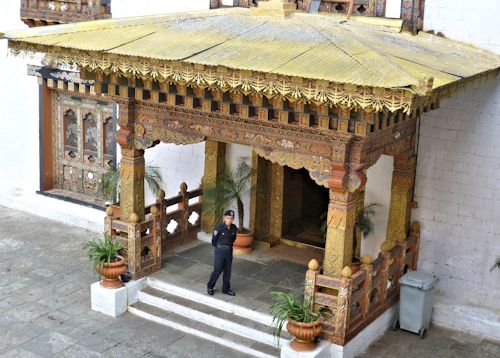 |
||||||||
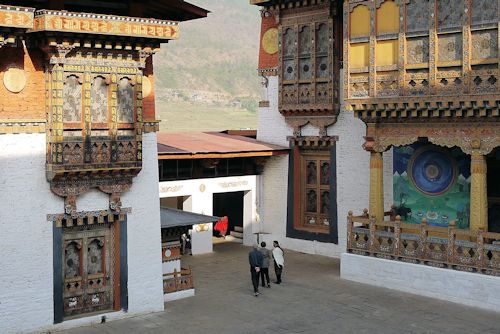 |
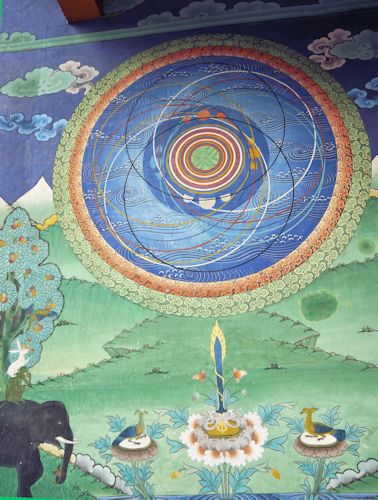
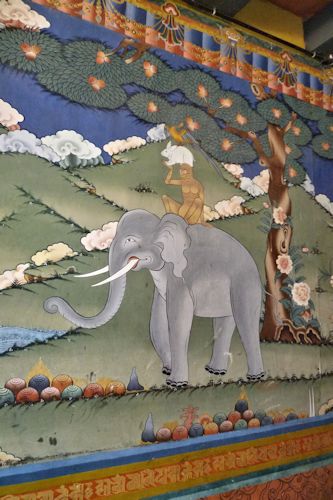
More murals around the courtyard |
We returned to the same hotel 'Damchen Resort', nice room looking out on to terrace by river. |
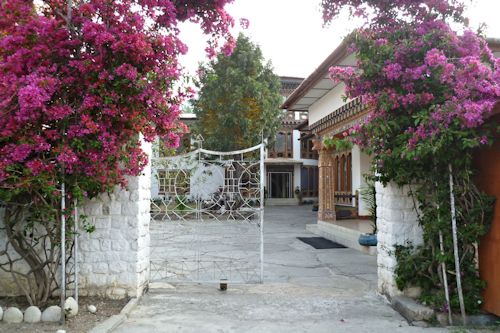 |
||||||||
| Return to top | |||||||||||
| | |||||||||||
| |||
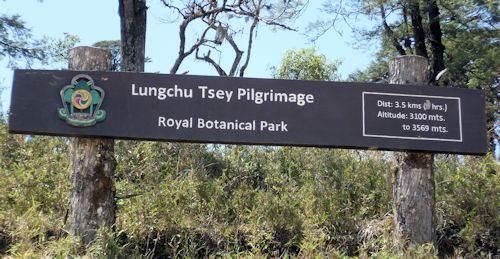 |
We stopped at the Dochu La pass cafe to collect our packed lunch,
then set out on a long ridge walk - 2 hours uphill to the lunch stop,
then another half-hour out-&-back up to the Lungchu Tsey gompa. (469m climb).
The path climbed behind the '108 chortens' at Dochu La, then up through more rhododendron forests. |
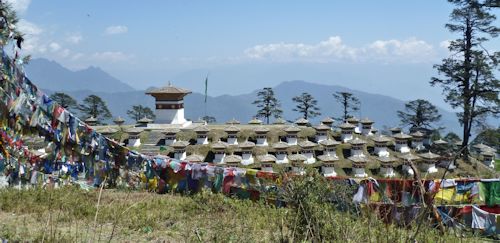 |
|
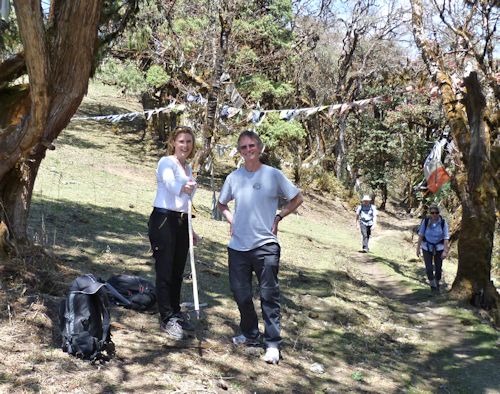 |
Distant view of the snow-capped sacred mountain Jomolhari from the lunch stop. |
The chorten and gompa at the top were very small, with just a caretaker monk who seemed glad of some company. But the vista of the snow-capped Himalayas was spectacular, if somewhat hazy. | |
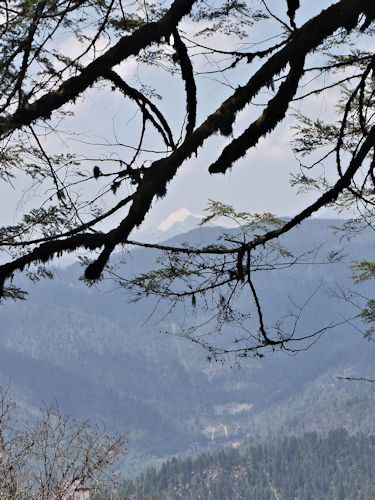 |
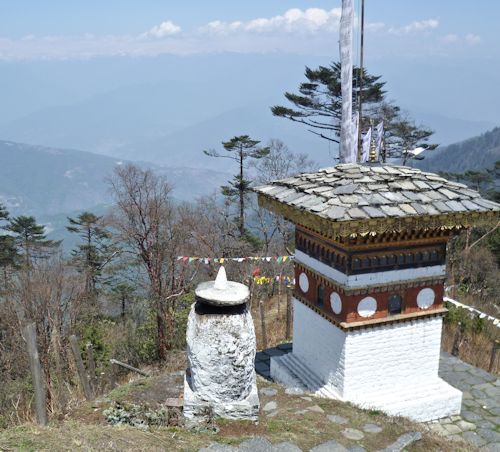 |
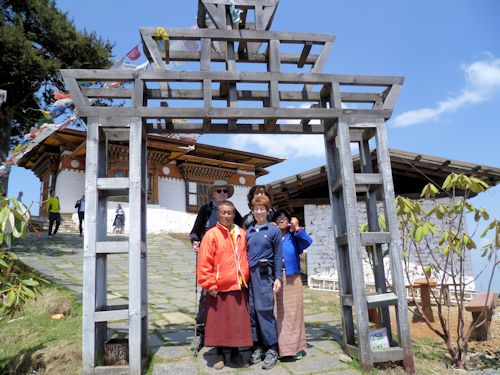 |
|
| We followed a long easy track downhill past the Trashigang gompa, then another 3 miles on a dirt track down to the road to meet our bus, for the half-hour drive to our large city-center hotel in Thimphu (capital of Bhutan). | |||
| Return to top | |||
| | |||
| ||||||||
Day 13: Tuesday 22 AprilSunny, warm.8:30am bus this morning, for a drive up the Wang Chu valley to our short hike up to Cheri (aka Changri) Gompa. | ||||||||
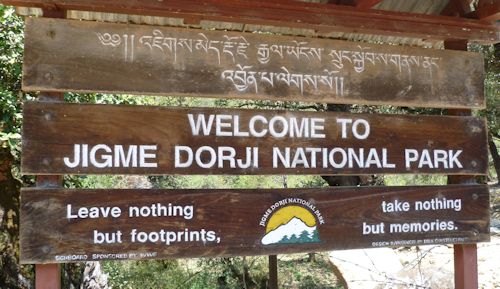
We started near the boundary of the vast Jigme Dorji National Park conservation area, crossing the river by a modern substantial footbridge. |
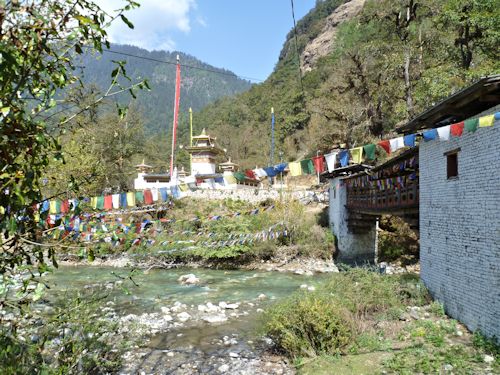 |
On the way up, an odd colourful grouping of a chorten, prayer wheel and Bhudda statue.
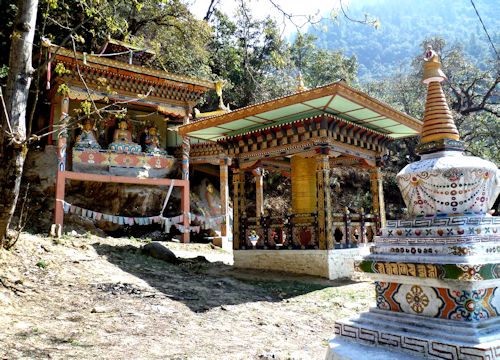 |
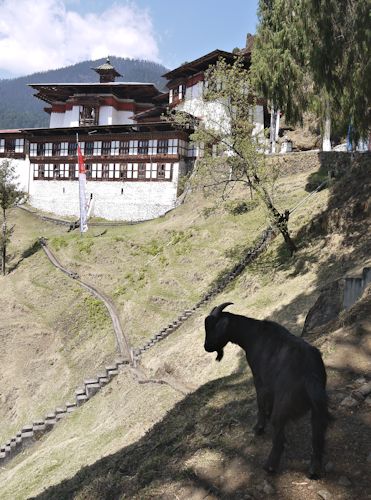
After about an hour, we reached the Gompa, following a steep path (terrain more suited to the local goats). |
|||||
|
||||||||
| | ||||||||
| We drove back to a restaurant in Thimphu for lunch, after a couple more photo-stops. | ||||||||
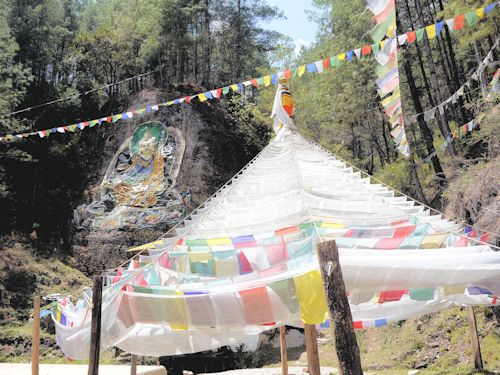 |
First, a vivid wayside rock-painting of Guru Rinpoche, with an unusual tented arrangement of prayer flags. Then a view over Thimphu: another large Dzong (holding the main government offices), the small Royal Palace bottom right, and the golf course (concession to the modern world?) in the foreground. |
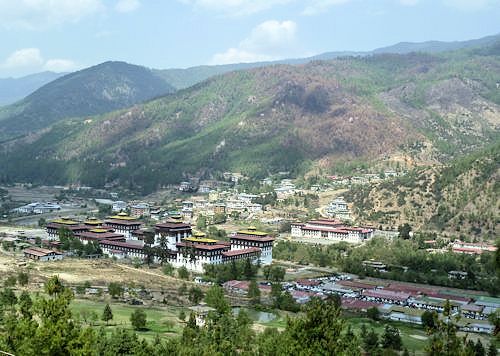 |
||||||
|
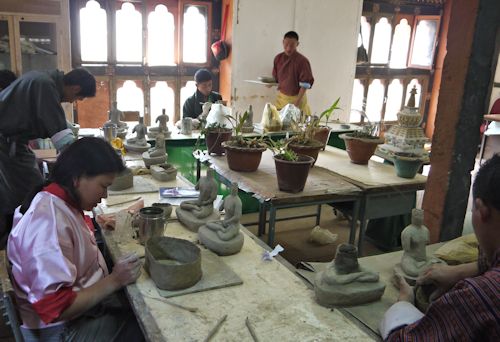
The arts school: non-academic students are encouraged to learn traditional painting, pottery and carving. 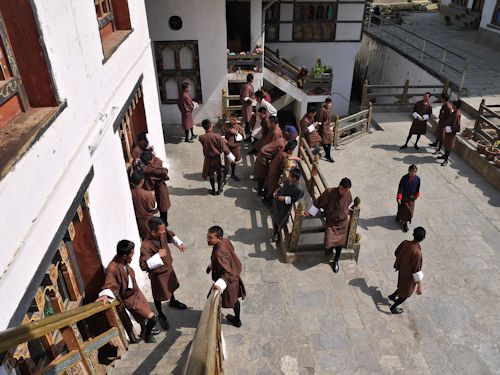 | |||||||
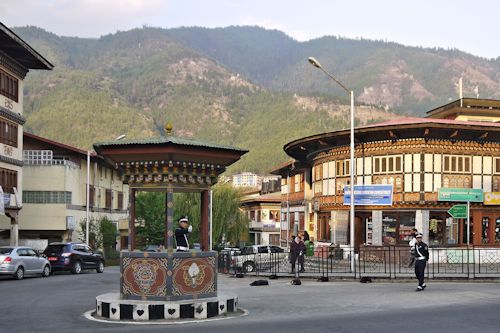 |
Returning to the hotel, we had time for a look around the town centre.
There are no traffic lights in the town, just a policeman directing drivers.
Building work appeared hazardous - 'scaffolding' consisting of bamboo poles roped together! |
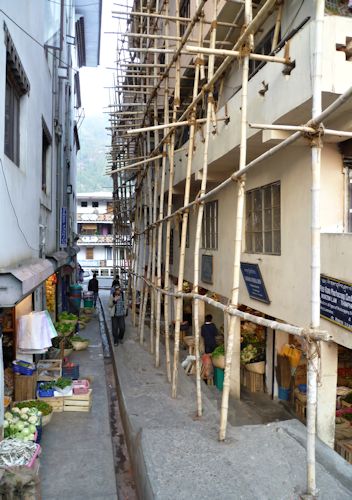 |
||||||
| Return to top | ||||||||
| | ||||||||
|
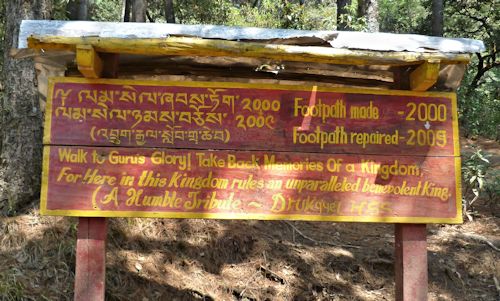 |
|||||||||
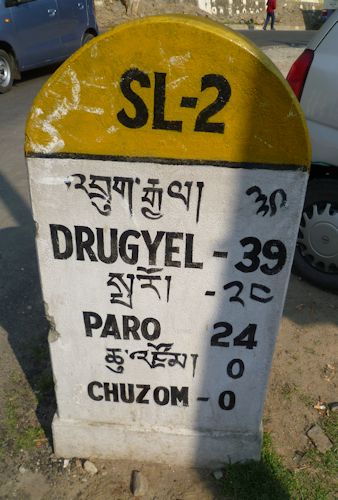
Paro milestone - at the confluence of rivers Wangchu and Parochu |
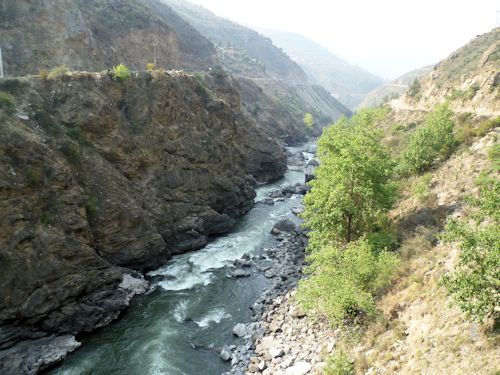
Wangchu gorge |
|||||||||
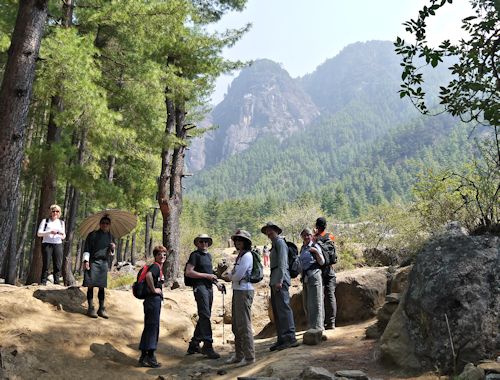 |
At the start of the wide, well-worn dusty trail. There was the option of a pony ride (up only) but they didn't look at all comfortable. | 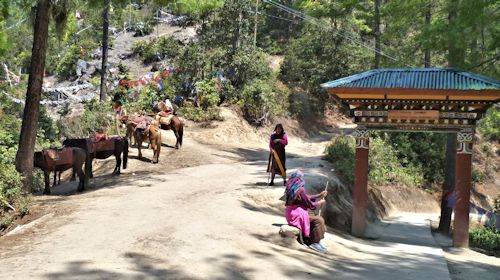 |
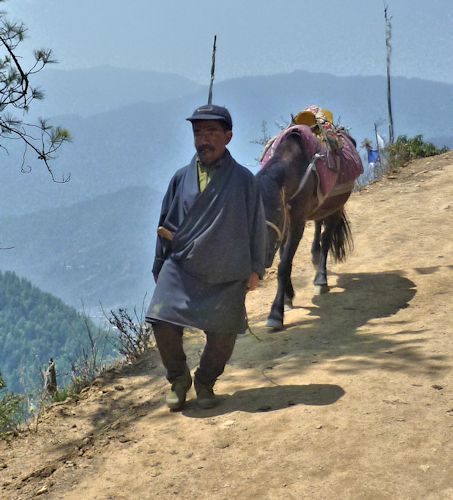
The state of ones legs after going up and down here every day! | |||||||
|
||||||||||
| Return to top | ||||||||||
| | ||||||||||
|
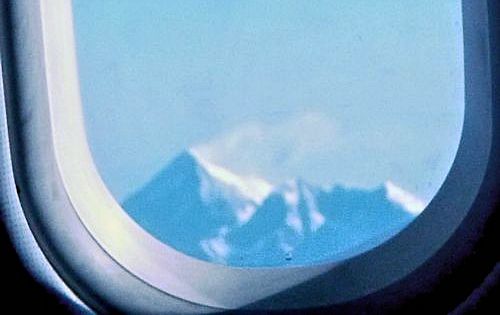
Another glimpse of Everest, from across the cabin. |
||
| We arrived back at the Dwarika hotel in Kathmandu by 9am, with a 'free' day ahead. A short walk around the hotel confirmed our dislike of the area, though we did find a Nepali restaurant for lunch. A lazy afternoon by the hotel pool, then back to the restaurant for dinner, where we tried the local 'Sekuwa' specialty - too hot and spicy for me. |
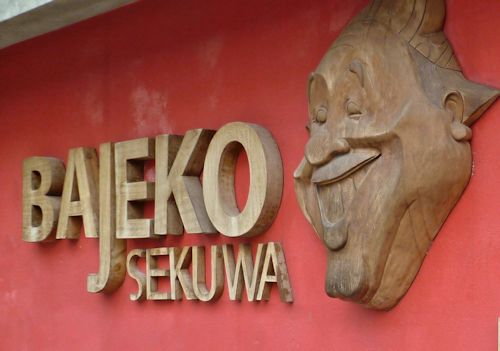 |
||
| Return to top | |||
| | |||
|
|||||||
| We were surprised to have to pay a substantial entry fee to the square, it seemed a rip-off but did include entry to the museum. As we had only exchanged a minimum amount into rupees, we had to find a bank, and queue to get some more. |
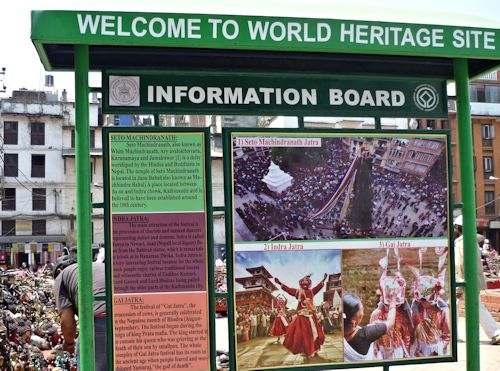 |
We didn't really appreciate it's 'World Heritage' status.
The mixture of styles of temples and statues around the area were interesting, but they were just dotted all over the place with no apparent relationship. And there were too many people, too many pigeons, too much hustle, and far too many scooters speeding around. |
|||||
|
|||||||
|
|||||||
|
|||||||
|
|||||||
| Return to top | |||||||
| | |||||||
|
||
| Return to top | ||
| | ||
Return to Holidays menu.
